#'len is a matrilineal line
Note
Why do like 90% of males think male homosexuality is disgusting? I read somewhere that they think it's as gross as rotten flesh 😭 also why do they laugh at it and make jokes about it too like they can't take it seriously? They're so insufferable, I see this so often. Not that I care about their opinions but they're the same kinda guys who gave yaoi loving girls the name fujoshi meaning "rotten girl" because that's how disgusting they thought they were. Freaks. It wasn't like this in ancient Greece, was it? What changed? Now they're more annoying. Before they were only misogynists and not homophobic but now they're both :/
Hah. This is one of the ramifications of the well entrenched patriarchal system in the midst of which, we live and operate. It has always been like this. Didn't happen overnight. It's intricate and quite a bit of it is invisibilised and the rest is normalised. It's better in some places, worse in others. But it's everywhere barring pockets of tribes which are matrilineal, which seem almost inconsequential in the larger picture of things.
Within the patriarchal set up, men also are conditioned to potentially satisfy certain expectations, whether it be of a provider or a leader, decision-maker. They are taught that certain things are acceptable where others are taboo. A heteronormative society, whether it be a man or a woman, would glorify or normalise heterosexuality and denigrate anything that comes into opposition with it. Heteronormativity is the narrative they grew up with, that's how they were conditioned. They were inspired by or impacted by their parents, neighbours, teachers, members of their peer group, also heteronormative, who reinforced these narratives and with time, they became a line that is not to be crossed. Taboo.
These dudebros online are just insecure little boys. That and very dumb. Naruto is shounen battle manga and most men/boys take it for granted that it's targeted at them (because it is) and they do end up enjoying it. When you have got super straight and super popular shounen MCs such as Luffy or Goku, it just reinforces the notion that Naruto also will be the same way. And Naruto the story does have all the nuts and bolts of a typical shounen manga, even if it also has a lot of other stuff that is a bit more subtle. A lot of dudebros really relate with Naruto and proudly. A lot of them incelish. Imagine how they would react to the fact that Naruto is gay. Lol. It really troubles their sense of masculine identity to think Naruto could be gay, that's why so many of them would get so bothered whenever Naruto would get super focussed on Sasuke. Lol. And so many of them think that Naruto was wrong to 'let Sasuke free' at the end. According to them, it was unpatriotic. Because that's what they think this story is about. Lol.
Like I said, most Naruto fans are way too attached to their lens. It's emotional for dudebros too. And you can't really argue with an emotionally affected illogical bigot. That's just too many odds against reason lol. They also think Itachi is hell's bells. Itachi is a Sigma male for them. I bet you can find many dudes who fangirl over both Itachi and Andrew Tate. Hahaha.
They are both misogynistic and homophobic, they have always been. Misogyny kinda goes hand in hand with homophobia with these men. Anything that threatens their narrative about men, women and their heteronormative m/f dynamic, will trigger this juvenile, bigoted behaviour in them. And their sense of entitlement as men makes them think they can get away with it. They do get away with a lot of times because reasonable fans usually don't invest in them, considering it a waste of time.
When I was in school, I had a few male members in my group. Three of these boys were very close. Straight boys. But you know, they were growing up, their hormones were welling up. One time, after graduating from school, we were drinking and one of these inebriated boys told me this. In school, after the sports period, they would take a shower together and sometimes, they would jerk each other off. Straight boys. They were curious and their sense of sexuality was not consciously set in stone. They didn't think of it as an overtly sexual act, for them, it was just boys having fun. They would get bored of jerking off themselves so someone else's hand did the trick for them. Another boy. A very good friend. When my friend later told me about it, he was aware how sexual an activity it was. He had realized that it was 'controversial', it was 'gay' and he felt guilty about it. He felt shame. So did the others, so they made a pact to never talk about it.
Kids often indulge in sexual acts while not being consciously aware about its nature. They are discovering their sexuality, their newly minted desire, their changing bodies, the unsettling surge of sex hormones. It's understandable. A lot of kids unconsciously experiment with overt or not so overt sexual acts without being consciously aware of what it implies. Which is understandable. I have heard such accounts from many men. They would never share it with another man though. Their sense of male masculine pride would shatter. Doesn't help that more often than not, there's no one to talk to them about it. Most parents don't, especially in conservative societies. No one to tell them what's right, what's acceptable, what's certainly not. Sex is still a very taboo subject among a lot of societies. Even reproductive sex, and not just recreational sex.
If someone had reassured those boys at the time, if someone had talked to them about it in a balanced way, perhaps their sense of sex and homosexuality/sexual orientation would be more mature, less prejudiced, more inclusive. Don't look at me, I was also quite young, I had not started delivering sermons and lectures yet haha. I did laugh my ass off when he told me though. It was not helpful at all. Hahahaha. You should have seen his face.
It's sad how so many grown and mature men still feel icky about homosexuality. I have seen so many of them who wouldn't be overtly homophobic but they would still show it in some way or the other. One time, i was working on a project where one of the team members was openly and flamboyantly gay, and my very 'liberal', foreign educated, upper middle class male boss hired him on an urgent basis and then appointed me to supervise him. One time, I needed some approvals so I told the boss to talk to him directly. He said no. He acted like it creeped him out, made him uncomfortable. For the rest of the project, I had to act as the liaison, which was fine for me, we became good friends. But it was pretty clear how 'open minded' my boss really was and how entitled he felt to be wearing the mantle of 'liberalism'. He was also a misogynist under the garb of feminism. Another member of the team, a woman, was fired by him. Now she was definitely to blame for her otherwise unprofessional behaviour, but one of her concerns about mistreatment by one of her own assistants (male) should have been addressed with respect. It wasn't. Instead, she was made fun of by the boss. He simply bypassed her complaint about harassment by her male assistant.
My boss would also make fun of the gay man behind his back because of his 'body language' and 'feminine' disposition. He would do it subtly, like it was just harmless ribbing, just a joke. But of course it wasn't. It was more than microaggression. It was disrespectful and very homophobic. I have seen so many men act like this, and it's crazy how so many men never talk amongst themselves about it. In my circles, they would tell me because I am not too judgmental, because I am a woman and because I am not conventionally 'feminine' in opposition to their conventional 'masculinity', which always seemed to reassure them. They thought of me as just one of the guys. I am not. I often found it funny but also quite sad.
So many of these men would open up only after getting sloshed. Their inhibitions would only be relieved when under the influence. Imagine all the energy spent on towing this line, the way both men and women are conditioned how to be.
A five minute shallow interaction online isn't going to do the trick. These men need to be rehabilitated. Their notions about sex and sexuality with respect to the world in all its inherent diversity need to be reexamined and changed where needed. It's difficult to feel sympathy for such men, yes. Some of them. But I am sure they will not be receptive to aggression, they have a degree in aggression themselves. You need to find their emotional Achilles heel, a chink in their armor, to find an in. It's honestly quite easy to crack most men. If you wanna break them, hit where it hurts most, their ego. If you wanna gain their trust, play up to their ego.
Why call them freaks? Lots of women also act like them. It's quite easy to see why they act like it too. We all come with our notions. We all have certain narratives we have grown up with. Certain hardlines we aren't supposed to cross. Certain socio politico cultural structures that reinforce these narratives that form the foundation of our lived experiences from babyhood that most people don't question, whether it be men or women. Our society was not built to be conducive to questions or challenges. It was built to repress them and eventually squash them. So obviously, we aren't able to reach an understanding about something that needs empathy and an open mind, that could really benefit with a balanced dialogue. Especially something that needs us to relook at our belief systems/established narratives. Such as feminism, homosexuality. What we don't understand, we hate or fear or revile.
One would really need to hunker down and have a proper dialogue, if you really want to change these narratives. It would take time and effort and lots of patience. You would need to invest. Build a new narrative. Look at all the ingredients that make up these narratives and start at the root. Change them one at a time. Unless that is done, one cannot convince them of Naruto and Sasuke being gay and it being a gay love story.
28 notes
·
View notes
Text
Culture of Tattoo Ainu:
The modern Ainu term for tattooing is nuye meaning “to carve” and hence “to tattoo” and “to write”, or more literally, sinuye “to carve oneself”. The old term for tattoo was anchi-piri (anchi, “obsidian”; piri, “cut”).
For the Ainu, tattooing was exclusive to females, as was the profession of tattooist. According to mythological accounts, tattoo was brought to earth by the “ancestral mother” of the Ainu Okikurumi Turesh Machi who was the younger sister of the creator god Okikurumi.
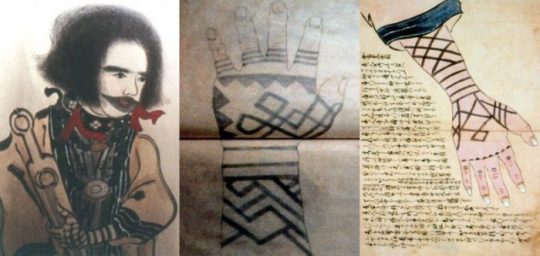
Because tattooing represented an ancestral custom derived from one common female ancestress, it was continued down through the centuries in the matrilineal line. Viewing tattoo practices through the lens of kinship, it is not surprising that the position of tattoo artist was customarily performed by grandmothers or maternal aunts who were called “Tattoo Aunts” or simply “Tattoo Women”.
The completed lip tattoos of women were significant in regards to Ainu perceptions of life experience. First, these tattoos were believed to repel evil spirits from entering the body (mouth) and causing sickness or misfortune. Secondly, the lip tattoos indicated that a woman had reached maturity and was ready for marriage. And finally, lip tattoos assured the woman life after death in the place of her deceased ancestors.
Apart from lip tattoos, however, Ainu women wore several other tattoo marks on their arms and hands usually consisting of curvilinear and geometric designs. These motifs, which were begun as early as the fifth or sixth year, were intended to protect young girls from evil spirits. One motif, the braidform pattern, consisting of two rectilinear stripes braided side by side linked to a special motif, represents a kind of band also used for tying the dead for burial. Other marks were placed on various parts of the body as charms against diseases like painful rheumatism.

As with burial cords, the braid-like weave structure of women’s plaited girdles called upsor-kut were embodied with a similarly powerful supernatural “magic” symbolizing not only a woman’s virtue, but her “soul strength”. “bosom girdles” were objects worn underneath the woman’s outer garment (attush) and kept “secret” from Ainu men. They were made of woven flax or native hemp varying in length and width and in the number of strands. Composed of either three, five, or seven plaited cords (sometimes alternating with intersecting or overlapping lozenges or chevrons), they closely resemble the tattoo motifs that appear on the arms of Ainu women.

“The tattoo marks are placed especially upon the lips and arms, because they are the most conspicuous parts. They are put there in order to frighten away the demon of disease. Now the wives of the heavenly deities are every one of them thus tattooed, so that when the demons come, and find that the Ainu women are marked in the same way, they mistake them for goddesses, and forthwith flee away.”
However, tattoos and girdles were connected on yet another, more metaphysical level. The Ainu believed that the fire goddess Fuchi provided Ainu women with the original plans for constructing the sacred upsor girdles. As noted earlier, Fuchi was also symbolized by the soot used in tattooing practice thereby linking the traditions of tattooing and girdling to Ainu mythological thought. And because each type of girdle was associated with a particular kamuy, it can be suggested that particular tattoos were perhaps associated with specific deities: “the wives of the deities were tattooed in a similar fashion as the Ainu women, so that when evil demons would see it, they would mistake the women for deities and therefore stay away”.
Interestingly, girdles were received upon completion of a girl’s lip tattooing just before or on the occasion of marriage. The design specifications of the girdle were passed down by the girl’s mother; she instructed her daughter how to make the girdle and warned that if it was ever exposed to any male, great misfortune would come to her and the family.

Eight types of upsor with each form related to a different line of matrilineal pedigree and associated with several animal and spirit deities (kamuy), such as the killer whale, bear, and wolf crests. Thus aristocratic women, especially the daughters of chiefs (kotan), wore more powerfully charged girdles than common women, because their ancestry connected them more closely to the kamuy. Munro also observed that the daughters of Ainu chiefs were tattooed on the arms before any other women in the village, suggesting that these types of tattoos conferred prestige and social status to the wearer. In this sense, tattoos and girdles appear to be functionally related.
Frogs and Tattoo
It is curious to remark in connection with tattooing that the Ainu fancy they can see tattoo marks on frogs resembling those made on the women. The following legend concerning the origin of these creatures is peculiar, to say the least, for it tells us that their first parent was neither more nor less than a woman who was cursed by God, and had her bodily form changed, on account of her great wickedness.
He metamorphosed her as a punishment, and her human spirit was turned into that of a demon. All that was left to show that it had once been a woman, were very slight traces of tattoo marks, which may still be seen, if one will take the trouble to look carefully on the legs (hands) of the frog.
'In ancient times there was a man and a woman who became husband and wife. After the first few months they did not get on well together, because the woman was discovered to be a bad character, and proved undutiful to her husband. She was also disobedient to her parents, and in the end bewitched them so that they both died. In course of time she married no less than six husbands, every one of whom she soon killed. God observed all this, and was very angry with her, so that He punished her by turning her into a frog, and throwing her far away into a marsh.
At the same time He said to her: 'O thou wicked woman, I indeed made thee good in the beginning, but thou hast lived an abominable and iniquitous life; thou hast not only slain thy father and mother and husband, but others besides. I am therefore now going to turn thee into a frog; thou shalt henceforth live in the marshes, lakes, and ponds, and thou shalt become a fiend. Thou shalt spawn young frogs, and hop about amid the slime of the most filthy places. If thou dost venture into the dwellings of men they will without more ado knock thee on the head, and throw thy dead carcase away."
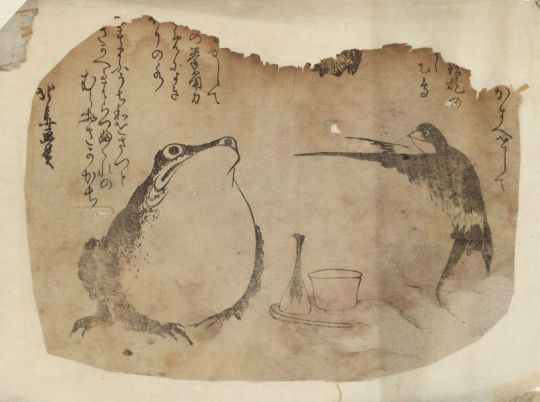
'So spake God. And this then is a true account of the origin of frogs; any person will find, if he examines them closely, that their feet are slightly tattooed, like the fingers of a woman. It is because a woman was the ancestor of these creatures that they have the marks of the tattoo left. Now, there are some people who, out of sheer pity, say in so many words that frogs are divine; but they are not so in reality, for they are demons, and something akin to ghosts. Yet, as they were once human, and followed the customs of men and women, they still go to the Japanese of the main island every winter and do their marketing, and when they return eat, drink, and make merry in their dwelling-places. This is the noise one hears in the spring when they cry, Ooat, ooat!
-América Briceño.
4 notes
·
View notes
Text
runalenwe's full name, for the record, is Runalenwe Ulyrel 'len Olnewil Faryedil Linaarie 'ata Illmeron Eancano Galanen 'cal Duuralia-Corlayenel
#moriada#oc: runalenwe#'len is a matrilineal line#'ata is a patrilineal line#and 'cal are the two clans she descends from#based on someone's analysis of that one altmeri full name we got from eso summurset
4 notes
·
View notes
Text
Not to go off on a half-baked meta at 5:30 in the morning, but though Zuko doesn’t realize it, he’s released from any filial obligations towards his father the moment Ozai burns him. Confucian tradition it is taboo to mark or damage one’s body, as it is considered a gift from your parents. As such, hair cutting, tattooing, branding, and forced amputations were used as forms of capital punishment in ancient times. Within the context of Avatar, it is not unreasonable to conclude Confucian inspiration in Fire Nation culture, given that we see both Zuko and Iroh cut their hair once officially branded as traitors. Using this lens, irony of Ozai forcing filial dishonor upon his son is glaring.
But in addition to being the horrific act of child abuse that the whole fandom knows it is, it has implications within the sociopolitics of the Fire Nation. I’m pretty fucking sure physically branding one’s child is a violation of the parent-child aspect of Five Constant Relationships (as well as ruler-subject, which has more implications worth discussing when I’m more coherent), but the point is Zuko has no obligation to Ozai - or, arguably and more importantly, his bloodline.
I wonder if, in-universe, this broken social contract would legitimately cement Zuko’s good standing as a ruler among the supporters of a peaceful world. If an argument could be made that the ruling line of Sozin ends with Ozai, and that despite gender politics and it being his matrilineal heritage, Zuko is more accurately the first in the ruling line of Roku. The symbolism of Roku having been gifted the artifact of the Crown Prince is not lost on me.
But that’s also a conversation for when I’m more coherent.
#atla#alex tir talks#disclaimer that I am one (1) Chinese person out of Very Many#other folks with Confucian backgrounds may disagree with my conclusions#I cant speak for everyone#meta#ella#but also...I LIKE this#especially with the Confucian social contract violations in Sozin and Roku’s relationship???#fuck#abuse#my meta
123 notes
·
View notes
Note
hi westover!! i was curious on your take of altmer culture (love it btw i always play altmer in skyrim) and their names? what do you mean by lineages and house names?
As we don't know much about Altmeri Culture in general, I have taken a good amount of liberties to construe most of what I consider canon in my own little sandbox, both from other High Elf lovers and worldbuilders among the Elder Scrolls fandom.
Very long response below, take heed.
In regards to Altmeri naming practices, we do have an example from ESO from Lirendel's Family Shrine. It reads as followed:
"Auri-El's honor and praise to the line of Nivulirel. Let this august name ring out among the stars. Behold! Behold the name of the glorious forebears.
Rumilion 'len Inecil Culanarin Salolinwe 'ata Piryaden-Itelnoril Hilnore Firlamil 'cal Ternerben-Nivulirel"
Continuing on, we also have a mention of naming practices in 'Guide to Altmeri Culture' where the excerpt of Chapter 47: The Art of Dueling, it mentions that: "Prior to the duel, both parties must recite their adversary's full name—taking care to call upon matrilineal, patrilineal, and clan honorifics where appropriate. Duelists who stumble over or mispronounce their adversary's name must stop and recite the name in its totality twice more."
So to break it down, we know that Altmeri full names are rather complicated and call upon both matrilineal and patrilineal heritage.
We know that ata/at mean 'father' in Ayleidoon and Aldmeris and so can assume that 'len is the reference to the matrilineal side of the family. So what about 'cal? In this case we can assume 'cal to be the clan name.
So Lirendel's full name would be Lirendel Rumilion 'len Inecil Culanarin Salolinwe 'ata Piryaden-Itelnoril Hilnore Firlamil 'cal Ternerben-Nivulirel.
Now, this is where we combine Westover's headcanons and Elder Scrolls canon.
Regarding matrilineal/patrilineal names a mer would name their most direct ancestors, going up to their great-great grandparent that is the same sex of their parent. So a mer would name their mother along with their matrilineal grandmother and their grandmother's mother.
Lirendel would be the GIVEN NAME, with Rumilion being the HOUSE NAME. 'len Inceil Culanarin Salolinwe would be the MATRILINEAL NAMES, 'ata Piryaden-Itelnoril Hilnore Firlamil would be the PATRILINEAL NAMES and finally, 'cal Ternerben-Nivulirel being the CLAN NAME. The hyphen would indicate this particular mer using both of their parents' clan names or is a combination of lineage-clan name.
This would all simply shorten to Lirendel Rumilion Ternerben-Nivulirel, which is still a mouthful, but many mer below the ruling class tend to go by honorifics rather than their family names.
In regards to lineages, lets use Almaliriel's family as an example. It has been mentioned that Clan Eruvarin's first ancestor was named Eruvarin of Sun's Dusk and is whom they derive their clan name from. Eruvarin had two children, Anyarsephona and Inginanye.
Anyarsephona's line died out by 3E 44, but had they been alive, Almaliriel's name would've been Almaliriel Inginanye Eruvarin. In 2E 583, Orestes (the Vestige) was granted by Eruvarin's Head of Clan to have his own lineage name.
It is mentioned in my author's notes that he is Almaliriel's and Elaine's (TheOneKrafter's Dragonborn) great-grandfather.
Had the mainline still been alive, Almaliriel's name would be Almaliriel Orestes Inginanye-Eruvarin, as the original lineage would've been kept.
Very large clans with many houses are known to have hyphenated names that can list six names.
As of 4E 203, in the AU where Almaliriel is the Dragonborn, she was given permission by her father (who is Head of Clan) to start her own house. Her and Teldryn's biological daughter (who has been alluded to, but not directly mentioned) name would then be Raena Almaliriel Inginanye-Eruvarin, with her full name being:
Raena Almaliriel 'len Almaliriel Elerina Indise 'ata Teldryn 'cal Inginanye-Eruvarin
As Teldryn is unaware who his biological family is (in my headcanon/canon) the patrilineal line would stop with him.
#westover answers#westover's tamriel expansion DLC#clan eruvarin#altmer culture#worldbuilding#ask me anything#thank u anon for asking this i had fun with the response#bonus content
11 notes
·
View notes
Text
Dowry vs. Bride Price: Westeros and Tyrosh
Westeros has a dowry system, where a woman is given wealth (commonly in the form of portable property) by her father’s family upon her marriage; in medieval Europe the property is usually hers or her children’s to use, but in Westeros her husband has significant rights over it and can be the chief reason for their marriage. The most notable example is Walda Frey’s marriage to Roose Bolton, where the dowry was her weight in silver paid by her grandfather Walder to Roose. Furthermore, Lord Lyonel Corbray is even more "well pleased” with his second wife’s “immense” dowry than with the girl herself, as she is the daughter of a wealthy Gulltown merchant. Westeros is based on medieval Europe and is clearly patrilineal (lineage is traced from father to son) and patrilocal (the family resides near the husband’s parents); dowries were offered in such societies where land is valued more than manual labor, due to the concentration of land ownership in the hands of the few (the aristocracy).
We don’t have many detailed instances of Tyroshi marriage, but the cases we do know about seem to indicate that Tyrosh has a system of bride price, where a man or his family give a woman (or, more specifically, her parents) property or service either just before or even during their marriage. Aegon IV explicitly promised some form of wealth to the Archon for Daemon to marry Rohanne of Tyrosh, which Daeron II had to pay for the marriage to take place; Yandel referred to the exchange as a dowry, but he is clearly looking at this situation from a Westerosi lens, as dowries outside of the Daemon/Rohanne marriage are only mentioned as being settled on women. Rohanne’s bride price may seem like a special case akin to Daenerys’ wedding to Hizdahr zo Loraq, where the bride is of a much higher status than the groom and so their union necessitates a reversal of custom, but Fire and Blood introduces another Tyroshi wedding that seems to follow the practice of bride service: that of Orryn Baratheon and the Archon’s daughter. We are most familiar with bride service from the biblical Genesis, in which Jacob serves Laban for seven years in order to marry Laban’s daughter Rachel (although Laban tricked him into marrying his eldest daughter Leah, so Jacob had to labor seven more years for Rachel’s hand). Orryn, exiled from Westeros for 10 years, took service with the Archon and within one year had married his daughter, although after the marriage he continued to serve the Archon until his term was over (in real-world societies including in ancient Jewish law, sometimes the service/price is not paid all at once and the groom enters a contract where he promises to pay what he owes). Orryn’s exile status meant that he had no family to pay bride price, so he needed to take bride service under the Archon to wed his daughter. Bride price/service occurs in societies where manual labor is more valuable than land, and we can infer Tyrosh, a heavily urban, small, “bleak and stony island” does not value land as the main source of economic wealth; rather, manual labor seems to be essential, whether through the institution of slavery (slaves are said to outnumber freeborn Tyroshi three to one) or from mercenary companies. According to an evolutionary psychology theory, bride price also originates from polygamy since there is a relative scarcity of unmarried women, and we know from Racallio Ryndoon’s dozen wives that some polygamy is practiced in Tyrosh.
Some inferences about how Tyrosh’s bride price custom and how that may have impacted Tyroshi-Westerosi relationships under the cut:
Tyrosh is majority uxorilocal/matrilocal, perhaps even somewhat matrilineal: bride service in particular necessitates the couple living close to the bride’s parents. The children of Rohanne and the Archon’s daughter were both raised in their mother’s lands; obviously from necessity in Rohanne’s case, but the Archon’s daughter never went to Westeros with her own daughter to try to raise her near Storm’s End after her father’s term was over. It seems fairly easy to assume that Tyroshi “citizenship” is based on the origins of the mother, as it was in ancient Rome (all children of freeborn women were free no matter their fathers’ status), GRRM’s model for Valyria. Matrilineality facilitates the incorporation of foreigners into the society, which is important for mercantile Tyrosh.
This is partially the reason for the imbalance between the number of Tyroshi men versus women in the books when this is not the case for their ‘sister cities.’ Several Tyroshi men appear in the books as sea captains and sellswords, and background Tyroshi sailors are easily distinguished by their dyed hair. Lyseni women have been significant side characters since book one (with Doreah, who is Dany’s slave) and are in-universe famous for being the beautiful consorts of Westerosi kings. There are even some Myrish women who have recent prominence in Taena and Serala (note: it isn’t said whether or not they are related to any Myrish magisters). The only Tyroshi women who have prominence are long dead nobility, Rohanne and Kiera and the Archon’s daughter (all three are certainly connected to the Archon in some fashion). In a matrilocal society, the women do not often leave their natal home (whereas in a patrilocal society women have to reside with their husband’s family), while the men frequently leave in order to make their fortune and thus be able to afford the bride price. If the city is matrilineal, the glut of male Tyroshi expats makes even more sense since they will not be able to inherit most of their mother or father’s property, so leaving the island is often the only way to make a decent living.
The bride price practice explains why Kiera of Tyrosh, unique among Westerosi royal consorts, was married to two Targaryen princes: Valarr died in 209 in the Great Spring Sickness, while Kiera’s only living child Vaella was born in 222. We don’t know when Kiera and Daeron were married, but the age gap between her stillborn sons (pre-208) and daughter is big enough (at least 14 years) that whoever Archon Kiera was related to might have had his term expire, and issues of her fertility might’ve caused other related Tyroshi women to be recommended for the crown prince. But the double marriage to Kiera may have happened because amid a country wracked by a devastating plague, ironborn raids, a hard-fought rebellion, and rampant tyranny, the crown simply did not have the funds to pay another bride price.
The Blackfyre daughters were able to marry well, whereas it was difficult to find matches for the sons: Daemon had seven sons, five of whom reached adulthood, but we know only of two or perhaps three (Haegon and Captain Daemon’s father; if you don’t believe Maelys was Haegon’s son, then his father as well) who had sons that carried on the Blackfyre name. In an aristocratic society with a dowry system like Westeros, the Blackfyre brothers could have traded on their noble birth and royal blood to marry an heiress (even a wealthy merchant’s daughter like Lyonel Corbray did), but in Tyrosh they would’ve needed to pay a bride price or spend years in bride service. This could explain why Daemon II was clearly not married by age 22 (yes he was gay, but so was Laenor Velaryon and he wed Rhaenyra at age 20), partially why Haegon waited so long to cross the Narrow Sea (he was in bride service beforehand, and after he needed a few sons to secure the succession), and perhaps even why Aenys Blackfyre traveled to the Great Council to become king while his nephew was crowned (he didn’t have a male heir). A bride price system might explain why the male Blackfyre line died out by three generations when there had been so many heirs, if the family wealth was mostly tied up in marriage dues.
As for the daughters, I’m fairly certain that after the family went into exile, the proposed betrothal between Aegor and Calla was scrapped due to lack of advantages (Aegor was now a landless sellsword whereas Calla was one of perhaps three exiled princesses and relative of the Archon). Calla or her sisters would’ve been a brilliant match for any ambitious, wealthy Essosi magister who wanted leverage over the Targaryens. Bloodraven’s statement in The Mystery Knight that Daemon II’s brothers and sisters would seek revenge if he executed Daemon II indicates that the sisters were powerful and capable of claiming the throne (if their brothers had died), which probably made them more attractive matches. The wealth their marriages brought the family might’ve helped the female line survive to canon era, though in a much better position than is usually speculated.
#asoiaf#asoiaf meta#tyrosh#marriage#asoiaf theories#Rohanne of Tyrosh#House Blackfyre#archon's daughter#orryn baratheon#kiera of tyrosh#calla blackfyre
49 notes
·
View notes
Text
some OOC thoughts on Gerry’s last name. tw for discussion of familial abuse, murder, and some controversial fandom opinions
like, don’t get me wrong, I am all about characters dropping their abusers’ last names and choosing their own. that’s something that’s very much valid in fiction and in real life, and we love to see it
but at the same time. it leaves a bit of a bad taste in my mouth that the only instance the t.ma fandom talks about it... is also the only character who originally took their name matrilineally? and the fandom’s most popular “solution” is to have him take his name patrilineally instead, even though he never even knew his father?
I dunno. it’s complicated bc I know it’s not just about patriarchal naming conventions, it’s also very much about how Mary was ... not at all the kind of person who should be trusted with the wellbeing of a child or any human being. that’s real. (I also get that part of it is out-of-universe, being a fan appellation for him rather than any implication that he would rename himself along those lines, but since my writing here mainly deals with Gerry in-universe, that’s the lens I’m taking here.) I’m just a bit, uh, side-eyes at how that happens to line up with reinforcing patriarchal naming conventions in the only instance where they’re shirked in canon.
I don’t have any issue with interpretations where Gerry drops the name Keay. like I’ve gone over, he’s got really really valid reasons for not wanting to carry that name! but what throws me for a loop is seeing everyone so determined to give him the name Delano instead.
through no fault of his own (I’m not trying to downplay the fact that he did very much get murdered by Mary), Eric Delano didn’t have much time in Gerry’s life. like, yes, we as listeners know how much Eric cared for Gerry, and we can see that Gerry has more in common with Eric than he does with Mary, but Gerry doesn’t have access to the same information that we do. he speaks vaguely about how his dad wanted to help raise him, but that was only ever a hypothetical to him, some stranger’s plan that never came to pass. he doesn’t know the sacrifice Eric made to try to be part of his life. he doesn’t consciously remember Eric at all, let alone have any reason to name himself after the man. which is tragic, yeah, I’m not denying that. it sucks that Gerry never knew Eric. but that’s still the reality he’s coming from when he thinks about his family and his name.
#I'll serve it in drag | OOC ⚿#and return from the ashes you call | RE: MARY ⚿#he said son when you grow up— | RE: ERIC ⚿
3 notes
·
View notes
Text
The Stream - Unlocking Women’s Innovative Potential

|| by matthew
The consumption of power has corrupted us. Men, from the time of King Gilgamesh, have taken control over the decisions of an immense amount of the world’s cultures.
And it’s greatly decreasing the speed at which our innovation should be moving.
Think for a moment. Besides the smartphone, wifi, social media, space exploration technology and the almighty procrastination medium YouTube, can you think of any isolated invention that has impacted general life that did not exist in some, more outdated (of course) form before the 21st century?
I believe that to keep up with our growing technological needs, we need to stop holding back half the planet’s population.
Sociobiology, the study of social life through the lens of biology, tells us something that we all likely already know. In the past and, to a lesser extent, now, intensity of labor, subordination of women, creation of female and male-centric roles, and use of symbols drove the structure of patriarchal societies.
But that’s clearly illogical. Think about it: what does the intensity of labor have to do with the capacity of any gender to envision the problems of this world and create solutions? A woman founded the world’s oldest university, 500 years before the age of universities in the Medieval Era. The introduction of smallpox inoculation, or a protection against infection, in Western Medicine was brought by a woman. Conservation of energy began from commentary on Isaac Newton’s most famous work by a woman. The first treatment for leprosy, or Hansen’s disease? The link between cholesterol and clogged arteries? The first to bring awareness of the effects of financial status, and gender and racial discrimination on health.
I can keep going…Really, I can. The point is: these advancements have been made in the midst of incredible adversity. Imagine what would have happened had we not stratified culture according to who can work in the quarries and who can manage the home? Imagine if the men went to work the fields and then returned home with their wife, who had just returned from a campus discussion on the efficacy of the current mores? Or if the women had the option to work with the scientists from the beginning?
There are, of course, cultures that are matriarchal. The Mosuo, for example, are a matriarchal and matrilineal society living in southwest China. Their particular style of living does not allow exclusive marriages yet encourages motherhood – something very strange to a Western audience. What this allows, however, is a culture that lacks many of the issues that plague relationships among participants of Western cultures.
With Unity Comes Progress
Many say that the problems of the largest units – countries – begin with the problems of the smallest – families and communities. Well what happens when a community is in complete agreement?
Question: Did you see Black Panther? A society where the women are just as valuable and respected as the men. The presence of vibranium did not automatically lead to new technology being created. It was the people within the country of Wakanda that helped develop that utopia.
And, of course, I would like to call attention to Shuri, once again.

To have a girl like her as a leader in this movie was, undoubtedly, purposeful. Let’s take notes.
She is:
a teenage genius with as much or greater potential than Peter Parker and Tony Stark (Spider-Man and Iron Man).
primarily responsible for the development of most of the key technology that was relevant in the movie.
responsible for the line that represents something that all people in science try to communicate – “Not magic. Science.”
smart enough to recognize the immense power that her technology gives them and still uses it or delegates who uses it responsibly.
representative for the potential of black girls and women in STEM.
If there was ever a reason for a character like this on screen, it’s what we just discussed. There is a distinct need for more. And speed of innovation comes from people with different experiences and ways of thinking. This is very simple, but I will add an analogy in the form of a question to clarify: How do you surmount a roadblock if everybody thinks the same way or has experienced the same thing?
That said, despite the logic of this argument in favor of tapping into everyone’s potential, we’re still at a point where women only hold 24% of STEM jobs and 30% of total STEM degrees. This problem is one that requires an overhaul of an ancient ideology to solve (like most problems surrounding tradition).
As always, the key is education. When more people are aware of an issue, it becomes more important to the group to solve it. When you need knowledge, find it. When you need perspective, ask for it. Our path to growth as a culture can only be through the input of all.

2 notes
·
View notes
Text
Perfectly Imperfect Dramaturgy: Danyah Miller @ Edfringe 2017
p.p1 {margin: 0.0px 0.0px 0.0px 72.0px; text-align: center; font: 12.0px 'Arial Narrow'} p.p2 {margin: 0.0px 0.0px 0.0px 0.0px; text-align: center; font: 14.0px 'Arial Narrow'; color: #272727} p.p3 {margin: 0.0px 0.0px 0.0px 0.0px; text-align: center; font: 12.0px 'Arial Narrow'; color: #272727} p.p4 {margin: 0.0px 0.0px 0.0px 0.0px; text-align: center; font: 12.0px 'Arial Narrow'; min-height: 14.0px} p.p5 {margin: 0.0px 0.0px 0.0px 0.0px; font: 12.0px 'Arial Narrow'} p.p6 {margin: 0.0px 0.0px 0.0px 0.0px; font: 12.0px 'Arial Narrow'; min-height: 14.0px} p.p7 {margin: 0.0px 0.0px 0.0px 0.0px; text-align: center; font: 12.0px 'Arial Narrow'} span.s1 {color: #2d2d2d} span.s2 {text-decoration: underline} span.s3 {font: 11.0px 'Arial Narrow'}
As part of the Edinburgh Festival Fringe 2017, Wizard presents
Perfectly Imperfect Women
Performed by Danyah Miller & Directed by Dani Parr
Award-winning storyteller, Danyah Miller brings her touching, funny, fast-paced, biographical piece,
Perfectly Imperfect Women to Pleasance Courtyard (venue THAT) from 2nd – Monday 28th August at 12.45pm.
Perfectly Imperfect Women explores what drives some females to want to live perfect lives as mothers, daughters, wives, sisters and bread-winners. Looking at our society the play questions what makes women want to be perfect and asks - what is so bad about imperfection anyway?
Looking at five generations of Miller’s own family, this one woman play examines the often complex relationship between mothers and daughters and the discovery that some women may have more in common with female bloodline than they care to admit.
LISTINGS INFORMATION: PLEASANCE COURTYARD (That) Wednesday 2nd – Monday 28th August, 12.45pm (except 14/21/28 August). Tickets £6 - £9.50
What was the inspiration for this performance?
I’m a storyteller. A couple of years ago I was invited to create a ‘female’ story. I said yes without knowing what stories I might tell: folktales, creation myths, legends? But I soon realised that there was a story demanding to be told, my biographical story.... I began to explore my matrilineal line, to consider the less than perfect relationship between myself and my mother through the lens of our female ancestors.
As I began to write and speak I made many connections between myself, my mother and her mother which surprised me. What was I passing on to my daughter I wondered?
The story was incredibly personal and I knew that whilst this was fascinating to me, I wanted to create a performance that also spoke directly to other women about their own relationships and about their drive to be better, or perhaps ‘perfect’ mothers, daughters, business women.
Is performance still a good space for the public discussion of ideas?
I believe that it can be, and often is, a great space for discussion and reflection - This show is a good example of that. When we opened Perfectly Imperfect Women in March this year (we did 7 performances in different venues) I immediately received a great deal of feedback from audience members saying how much the show had stimulated debate between them.
People who spoke or wrote to me later also commented on how they were still discussing the show, thinking about it, looking at their own stories
‘Fabulous, loved every minute and it hasn’t ended yet as I will peruse and ponder on my thoughts that you have left with me’
‘I think I’ll drink until Christmas! - so much to think about, so much to talk about. Thank you for making us think, question, speak’
How did you become interested in making performance?
Since I was a child the only thing I wanted was to be ‘in theatre’. I wanted to be on stage but as I grew up, not thinking I was good enough to be an actor, I became involved in marketing, administration and management of theatre venues. However with every new job, new step up the ladder, I tried to get closer to the creative process, always feeling that I was too far away.
When John and I set up Wizard Presents in order to produce our own shows I still felt that I wasn’t close enough to the ‘action’. I retrained at Lecoq in Paris and began to work in schools as a storyteller. This work felt hugely satisfying and led me to producing and performing in a small scale village hall tour of a children’s story, which I also then brought to the Edinburgh Fringe.
Since that time I have continued to create theatre and it is where my heart lies and where I want to spend as much time as possible. I feel privileged to enjoy a combination of producing, teaching storytelling at International School of Storytelling, performing and writing... these strands work perfectly together for me.
Is there any particular approach to the making of the show?
This is the third, one-woman, show Dani Parr (director) Kate Bunce (designer) and I have created together. We’ve worked in a similar way on each of the productions although each end result has been different. We have a basic story from which to begin but the show is created out of a devising and improvisational process which begins with us determining the answer to certain questions, for example: what do we want to say? Why this? Why now? Why me? We consider and decide the structure, the conceit and the parameters of the piece including how the design grows from these decisions and then informs and creates the world of the story.
We work very closely together for a period of time, then leave time and space for the ideas including design to emerge. A couple of months later we come back together to continue the process and have the ‘set’ and props in the rehearsal room as early in the second process as possible. Other creative practitioners work with us at different times, including voice coach, movement director, devising actors and other specialists. We always seem to run out of time as we get close to the first performances as the ‘words’ come last and the script changes right up to the last moment. For me, this is hair-raising to say the least....
Does the show fit with your usual productions?
Yes it fits really well into our family theatre work and into my own work as a storyteller (trainer) too.
What do you hope that the audience will experience?
What I love about art in general, and theatre in particular, is that you can never predict how an audience will respond to your work, either as a group or individually. Before I go on stage I always remember that I’m in service to the story and hope that the audience will receive it on many levels. I believe that there’s a magic triangle between the story, the teller and the audiences which means that no two performances are ever identical.
In Perfectly Imperfect Women, people have spoken to me afterwards about their stories and experiences, their mothers and how the show has stirred up their thoughts. I have heard people say that they want to come back and see the show again. I’m really happy with these responses and feel that the production is provoking questions and discussion.
‘I connected so much - I relate as a mother of three, brilliant. Funny, true and honest. Beautifully performed and cleverly staged. Thank you’ - Tracey
‘You touched me in so many places and ways - and your beautiful sensitivity and vulnerability illuminated this rich, true, wonder tale’ - Judith
‘Bold, courageous, entertaining, liberating’ - Matthew
What strategies did you consider towards shaping this audience experience?
I performed my original biographical story in front of a couple of audiences and received feedback from them, researched a number of other one-woman biographical performances and spent time with Dani (director), Kate (designer) discussing what we wanted to achieve with this production. We knew that we had some of the ingredients to make a compelling story but we also knew that we needed to throw everything up in the air and start again whilst exploring what connected the three of us, our families and our lives. We joked about our need to be perfect and questioned what perfect is anyway. We played with a range of structures and asked many questions, Is he need to be perfect uniquely female? What happens if we’re less than perfect?....
We were amazed at and delighted by the number of similarities we discovered between us. We laughed a lot and consoled each other too. We worked with the personal, the universal and the archetypal to create a modern day fairytale which we’ve discovered, to our delight, seems to speak to audiences on many different levels....
As one reviewer said ‘It is simultaneously her story, my story and our story’
Danyah Miller starred in ‘I Believe in Unicorns’ by Michael Morpurgo, which premiered at Edinburgh Fringe in 2013 before touring nationally and internationally. She received an Argus Angel Award for Artistic Excellence at Brighton Festival 2014 and an Audience Choice Award for ‘Get Creative Family Arts Festival’ in 2015.
Danyah also recently toured ‘Why the Whales Came’ by Michael Morpurgo. She was a regular storyteller on BBC Three Counties Radio and recorded a 5-part version of ‘The Snow Queen’ for BBC Radio Solent in 2014.
The production is directed by Dani Parr, who is Director of Participation at Almeida Theatre. She was previously Associate Director at Royal & Derngate Theatres, Northampton.
Dani directed I Believe in Unicorns for Wizard Presents. She also directed ‘Why the Whales Came’ which is currently on a national tour. Dani co-directed Moominsummer Madness, a co-production between Polka Theatre, Royal & Derngate and Little Angel Theatre and won two awards for Flathampton at Brighton Festival in 2013: the Argus Angel award for artistic innovation; and the Latest award for Best Children’s Event.
from the vileblog http://ift.tt/2tsCq5b
1 note
·
View note
Text
Sensing
Jan 1, 2017 – Of Vietnam, from Nom Khiaw, Laos
And now I exhale. Before a 1,000 foot looming karst that plays hide and seek in the mist of the Laos cloud forest, I embrace the rainy day while I sit on the thatch-roofed porch of my well-appointed bungalow at the interstices. These spaces in between, neither of this world nor outside it, not attached to past or future, breed reflection like no other.
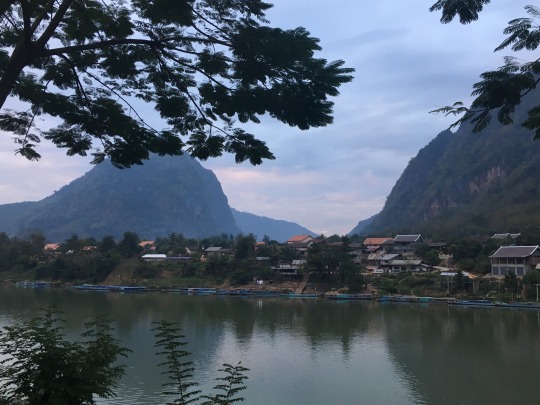
Preceded by a particularly immersive weekend meditation retreat, this travel experience, more than most, has allowed me to almost watch the ebb and flow of my reactions as a detached observer. I always find that displacing oneself from the familiarity of home conjures feelings of every extreme. The elation of a strong, steaming shower, after days without, can be replaced with shocking swiftness by the devastation of a boat trip to a coveted landscape cancelled due to unseasonable rain. Just as mercurial was the titillation I felt, on Christmas Eve in Vietnam, when my hotel staff performed a hilarious choreographed version of Uptown Funk in Santa suits – too soon followed by a sleepless night because India’s bureaucratic and labyrinthian e-visa website threatened to thwart my ability to gain entry in the country where I am committed to deliver a youth arts project in just 2 weeks.

However, I am no longer surprised when such unabashed joy erodes the moment another travel aspiration is dashed. I’ve ventured far from creature comforts often enough to realize that my daily happiness on the road is inextricably linked to the management of my expectations. And so I secretly hoard my hopes, like one does their vices (whisky under the bed or sweets in a hard to reach cookie jar). And instead I strive to absorb each travel experience like a sponge – neutral and receptive, as open to saturation as I am ready to be wrung out to dry.
Hanoi boasts more cafes than Vancouver, Seattle, and Portland combined. And one of our favorites was the Notes Café. Visitors are invited to leave messages on pastel sticky notes that wallpaper this three-story, 10-by-10 sliver, in the centre of town. On mine I wrote, “live every day like a traveler” by which I mean to savor every sensation like it’s the first time you’ve ever encountered it.

A lofty goal, but one far more easily achieved when a routine day includes the blood-curdling squeals of a giant pig as Hmong tribesman try to tie it, alive, to the back of their moped; the ubiquitous smell of fish sauce, cigarettes and singed flesh; the glories of a woman’s firm hand kneading all of your worries from between your toes; the taste of a liquid hot coconut pancake bought on the street for a quarter; or the hourly site of a mother tenderly picking lice from her child’s hair on the sidewalk, their family’s “dirty laundry” laid bare, the way it seems everyone lives their lives in this part of the world – in public, proud and shameless. Perhaps it’s why all their café chairs face outwards, where an endless array of stimuli abounds. Weddings are held in open downtown patios; men can get a shave or a haircut on every street corner; electrical wires hang in exposed, tangled webs draped from block to block; and cyclists ride past, dwarfed by enough wares to fill a whole floor of a department store. I envy such candor. We could all learn from their honesty. And I think such transparency lends itself to much deeper compassion.
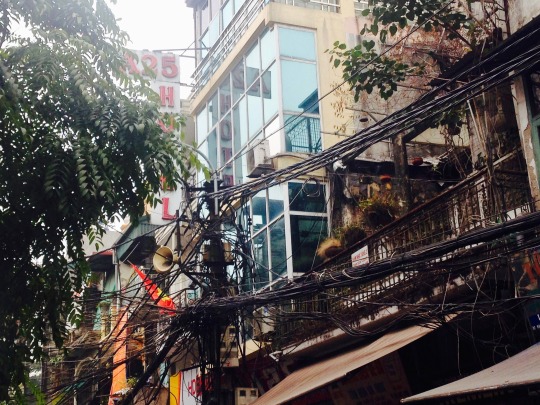
Sense-making
Jan 1, 2017 – Of Vietnam, from Nom Khiaw, Laos
Another favorite aspect of travel, for me, is sense-making. It was three days before we learned that the balloons cryptically sold at every Hanoi bar were filled with shisha (a flavored smoke enjoyed in Hookah clubs around the world). The same amount of time was required to realize that the amplified chant which woke us every dawn was communist propaganda emanating from the loud-speakers of their garbage trucks. Conversely, the donut ladies and shoe repair boys were a much quicker read. Not two minutes off our airport bus, we were accosted, unawares, by a woman in a triangular straw hat who popped free TimBits in our mouths. This seemed like a friendly welcome, but it turns out the same ruse happens every 15 minutes in Hanoi. So, we learned to keep our mouths closed when we passed them to avoid the pressure to buy more. Just a minute later, with our sore-thumb status confirmed by our rolled suitcases, a sharp-eyed, young male bent at my feet and proceeded to glue the sole of my shoe, near the toe, where it had begun to detach. While I reached for a 5,000 dong note (30 cents) to thank him, he had already grabbed his needle and mismatched thread, ripped my sneaker off my foot, and continued to repair the undamaged heel. Then, he asked for the equivalent of a whopping $10 for his unsolicited 2 minutes of labor and mismatched gold scar which he left on the treasured shoes that I’d bought on my last adventure, in Colombia. We settled on a buck, and I chocked it up to a great tale. Now, I’m just hoping that I’ll get them polished in Kenya then stolen in Paris so I’ll eventually collect a story from every continent.

There are sensations I count on as sort of traveler’s homing-devices in every part of the world. Rooster wake-up calls, unidentified prickly fruits, chromatic bird calls, steaming street food, traffic chaos, and smoky sunsets. Then, there are those unique to certain regions. And I have to confess that Asia’s tickle me most. The constant waft of Buddhist incense. The colorful light that paper lanterns lend to almost every setting. The gorgeous silks and embroidered textiles that line the markets like flags attesting to the efforts of the women who have toiled over these precious pieces. And then, of course, the delectable food that no amount of Delhi belly can deter me from trying. There is noodle soup, sticky rice, hot pots, curry, sweet iced coffees, teas, and fried bananas to name a mere few. My mouth is watering as I write. So much so, I think it’s time to break for dinner….

Travel Lessons
Jan 5, 2017 – Of Vietnam, from Luang Prabang, Laos
Certain insight can be revealed about a culture through one’s own eyes. The art nouveau propaganda posters that abound in Vietnam act as souvenirs that loudly scream of their unabashed hatred for the US during the “American War”, as they aptly call it. Conversely, a crowd of children yelling in a public park turned out to be a game of Tug of War – an ironic demonstration of their more peaceful present times. Thoughtfully restored French colonial structures and fresh baked baguettes at every café infer a certain reconciliation with their former imperialists. As did our experience on Christmas Eve, when we accidentally happened upon thousands of locals singing Silent Night in front of a jumbotron outside St Joseph’s Cathedral, where several hundreds more attended the service. Though a vestige of their colonizer’s religion, the profound sincerity of their adopted faith gave us chills.

Other truths have to be gleaned from more deliberate research. Hanoi’s impressive Women’s Museum (an institution I wish existed in every nation) taught me that females have been leaders in Vietnam for centuries (politically, militarily, scholarly and otherwise). Perhaps influenced by the history of numerous matrilineal tribes, women seem largely respected and included in Vietnamese public life – not only relegated to domestic responsibilities as we’ve observed more in places like India and Morocco. Of course, along with this has come grueling physical and low-paid labor, in sweat shops, on farms, and everywhere on the streets where you see them carry burdensome wicker baskets dripping with vegetables or chickens or toys, balanced by a mere bamboo pole that rests on their probably thickly calloused shoulders.

But I always learn the most interesting things from my direct interactions with locals. Hanoi is not without its hipsters. Microbrew culture is budding. Latte art and mojitos are easy to find. And the trendy Tadioto Bar was certainly the best example. This dimly lit, art-gallery-slash-20-seater drinking hole hosts Vietnam’s artsy literati types, along with the few foreigners who can find it. The 27-year old manager, who did not look a day over 16, returned to his hometown to swap philosophical banter with his clientele after a grad school stint in Wisconsin as a poetry major. And we were privileged to a long chat with him once the place had emptied. He spoke about a small but thriving educated class, eager to study abroad. He criticized the hypocrisy of the blatant consumerist values he perceives in Vietnam while it remains a Communist state. His female companion, (an actual 16-year old far too big for her britches, sipping tea amidst her adult peers while home on holiday from her New Jersey prep school), added that many of her compatriots were quick to capitalize on the ease with which a clever person could make good money in her country. And when we asked about the danger of dissent (like we’d previously observed in Cuba, for example), they shared that because many “revolutionary” thinkers can relatively maintain the comfortable lifestyle they want, within the current regime, their objections remain more ideological than action-based because their need to make waves is not great enough. Of course, such a conversation is merely a glimpse of their political reality, and received only through the lens of a few select opinions. However, it still added much richer hues to the picture of Vietnam that I had before my visit.
Tours and Chores
January 6, 2017 – Of Vietnam, from Luang Prabang

While I travel primarily to gain cultural insight, not all of my travel choices have such lofty intentions. I am also hungry for new experiences and certainly allow myself to indulge in occasional not-to-miss attractions along the way. In Vietnam, one of those was HaLong Bay, where thousands of mythically shaped karst mountains hold court in the South China Sea, like creatures out of a horror film. One can’t avoid sharing this World Wonder with 2,000 other travelers who dot the coast in orange-sailed junket boats on any given day. And whether you want to or not, you are shuttled through an action-packed itinerary that includes a cave trek, kayaking, and a cooking class. Not a bad combo at all, but the constant demands on our minute-by-minute behavior had me wondering if they’d dictate when I could pee or even breathe too. Such guided programs do, however, offer some surprises. And while I dreaded the visit to a cultured pearl farm, for fear of aggressive sales pressure, I was astounded by the lengths to which our species manipulates nature to mine it for the tiniest gems. After a test tube baby-like breeding process that mixes a dead oyster’s shell lining with organic flesh, they inject this into a living mollusk in the hopes that a drop will fuse with sand and other solid ocean matter to produce the coveted pearl. Of course, it only works 3 out of 10 times, and then only 10% of those pearls are “perfect” sellable specimens. So, with a 3 % overall success rate, it’s no wonder this laborious process reaps such expensive jewelry. I was left wondering who ever thought up such craziness and why, but that’s a disorienting state in which I often find myself as I travel, and I invite it.
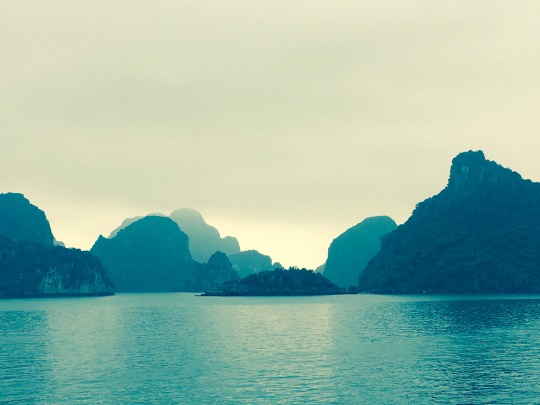
At the end of our two-day tour, we were mildly disappointed with the overcast weather that never lifted. But, for the most part, this only meant one less screen saver shot than we’d hoped. And, of course, that is never a real reason to travel. Meanwhile, the shrouded look did lend its own magic, and I still feel very grateful to have seen this one-of-a-kind landscapes.
Insights
January 9, 2017 – Of Laos, from Siem Reap, Cambodia
There are few places that can surprise anymore. Facebook, Instagram, the Amazing Race, our intrepid friends’ travel slideshow parties, and much cheaper, easier flights than ever before mean that at least someone somewhere has told you/showed you about nearly every place on earth. And though Laos is far less traveled to than most spots, surely some of our adventurous buddies had already ventured there. However, we’d resisted looking at their photos, or others, as much as possible prior to our trip. So, the country’s fifty shades of green, which barely resemble the same number that paint BC’s Sea to Sky corridor, were wonderous to discover.

The design sensibilities of the tribal weavers, the Buddhist temple-builders, and the interior decorators of Luang Prabang’s stylish cafes constantly exceeded our expectations. And the unwavering calm, clear-eyed joy of the Laotian people continued to amaze us while we failed to witness an exceptional case by our tenth day there.

But most shocking was the 100-year-old film, Chang, that documented daily Hmong life, deep in the Northern jungle, in a way that has not been rivalled before or since. It follows a loving family of four, in a scant stilted home, who lived at times in harmony and at others in discord with a host of creatures that surrounded them. Chickens, pigs, goats, giant lizards, pet baby bears, and howler monkeys they counted as friends or food. But leopards, tigers, cobras and a full herd of 400 elephants threatened them daily. It’s difficult to say what astounded us more - the boldness of this courageous filmmaker, or the preposterousness of this family’s efforts to outwit their far fiercer foes. Even more strange is the fact that the film is virtually unknown, and went entirely missing for almost 65 years until its recent rediscovery. So, while part of me wishes to keep Laos’s secrets amongst the few who are willing to go there and see for themselves, it would certainly benefit the study of Mekong’s indigenous people, and perhaps the anthropological understanding of other aboriginal cultures if this deserved film were to receive global circulation. However, for now, it is only available in the most quaint and romantic bike/walk-in theatre ever, each night at 7:30, in the garden of one of Luang Prabang’s most chic hotels – popcorn, beer and all.
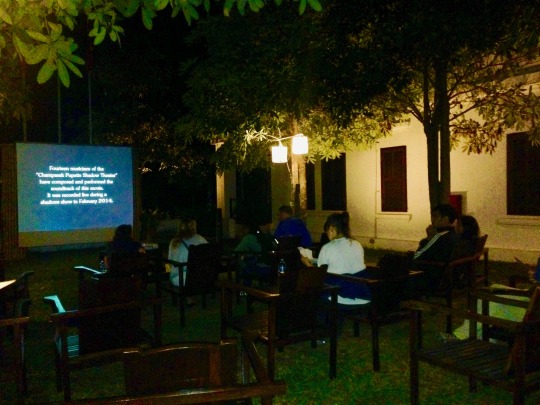
We were granted another privileged and intimate peek into Laos culture when we took a slow boat up the Nam Ou river with our guide Wong, whose story spoke volumes about his people. Wong was born in a remote Northern farming village, the middle child of 11 siblings – the boys outnumbering the girls by only 1. Raised by parents with a strong value for education, Wong woke at 3 am, from the age of 5, to have enough time to steam rice for his “lunchbox” and then walk a whopping 3 hours to the nearest primary school, only to study from 7-1 and then repeat the whole journey home, every afternoon, before dark. Wishing to improve his access to learning, Wong chose, of his own volition, to become a monk at the age of 11, which meant that he had to move to Vientiene, 600 kilometres from home, to study at a temple school there. He generously shared that he cried non-stop for his first 3-days, but his homesickness abated when he soon began to make close friends. It was 7 years before he even once returned to his village, but his parents did make the long bus trek, once per year, to see him.
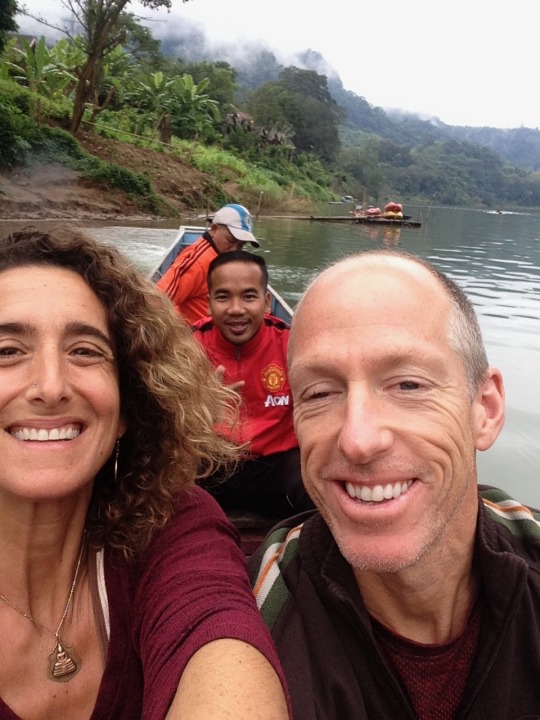
At 18, again by choice, Wong incurred a self-imposed fast, during which he remained in his room for 8-days of contemplative meditation, to determine if the monastic life was truly for him. He emerged spiritually strengthened but physically weakened, and his retreat was followed by a 6 days in the hospital. But his resolve to seek further university study and to one day marry caused him to disavow celibacy and asceticism. Most Laotians follow Therevadan Buddhism which allows for men and women to enter and exit monastic life (unlike the Dalai Lama’s Mahayana branch which requires a lifetime commitment), so Wong was not alone in his life transition. More than half of his childhood mates also left the monkhood and he sadly lost touch with all of them. His desire for love has not yet panned out either. He confessed to his discovery of Lao whisky and beer when he nursed a broken heart after his first love ended because he could not abide a possessive or jealous girlfriend. But his career aspirations did successfully lead him to complete degrees in English and Law. He also acknowledged that he knew he could be much more effective as a lay person, providing legal counsel to people in villages like his own, because many hill tribe people are not Buddhist and are thus less receptive to Buddhist monks.

So now, he has reached the arduous internship phase that his country requires of all bureaucrats. And this means that he must work full-time, without pay, potentially for several years, until he passes a very demanding exam to qualify as a legal officer. Meanwhile, he has to work weekends to pay for his living expenses, which is why we found ourselves scrambling into a limestone cave, swimming in jungle waterfalls, passing gargantuan 10-inch amphibious millipedes en route to a jungle waterfall, and kayaking cavernous river valleys with our charming guide who taught us so much.
View from Two Wheels
January 10, 2017 – Of Laos, from Siem Reap, Cambodia
Life is always observed most vibrantly for me from a bicycle. This slower two-wheeled pace, though faster than walking, still allows for careful observation of the people, places and things you pass along the road. And rather than to simply watch it, you are truly in it, moving as so many others do in the world, by human-powered pedal. Our Laos trip covered 300 k in 4 days, a manageable distance that still enabled us to cover some real ground.

Slipping towards and away from the Mekong and then Nam Ou waters, we were hugged by stunning views at every turn. But a few sights stand out in particular, for better or worse.
-Triangular-hatted women working impossibly green rice fields, just like you might mythically imagine in any rural Southeast Asian scene.
-Formerly-adorable, brown and black decapitated goat heads, on sale at the side of the road for god knows what culinary purpose.
-Straw roofs covered in drying river weed to prepare one of our favorite Laotian treats, kaiphen, a scrumptious nori-style roasted greens served with sticky rice.

-Another seemingly unnecessary gas station, no less than every 10 k (5 times more prevalent than guest houses, for sure). We figured this gave the residents of the tiny villages en route a way to fill up their motor bikes without having to travel too far, but the infrastructure for these fossil fuel beasts seemed incongruous amidst the primitive nature of the surrounding communities.
-And Hmong tribal children honoring their New Year celebration (Pei Mei) in incredibly festive traditional dress.

But the worst blight to our senses were the series of imposing dams which the Laos government has hired China Energy to build all over the country. I don’t think that there is any edifice that serves as a greater physical manifestation of humanity’s raping of Mother Earth than a giant concrete dam. And the thoughtless red spray-painted numbers scrawled across hundreds of families’ homes, slotted for demolition, were a stark reminder of the displacement such projects incur. Even more tragic is the fact that Laos is overdeveloping its hydro power for its population’s needs. So, it plans to sell it to its neighbors. Little beautiful has been built in the name of greed and these Mekong scars are no exception.

Massage Dynamics
January 10, 2017 – Of Laos, from Siem Reap, Cambodia
It seems unfair that the aches and pains gained from a one-week bike tour could be so instantly and cheaply alleviated at your destination. But Luang Prabang is, indeed, the perfect landing spot for saddle sores, throbbing quads, and nagging shoulder injuries. The full menu of body treatments is available there (foot, Thai, Swedish, hot stone, or head massages). And we availed ourselves of all of them. When I pay a pretty penny for this luxury at home, I think I take for granted the true preciousness of the exchange. But somehow, when such bliss is doled out for less than $10 an hour, I am struck by the intimacy and privilege of having a complete stranger come into such close and loving contact with your flesh. Usually these are wordless encounters delivered by nameless people, which should not seem so touching (pardon the pun). However, the Laotian touch moved me. And because some of my former foreign masseuses have so mindlessly dialed it in (checking Facebook as they annoyingly rub the same 4 inches of my calf for ten minutes), I know the difference when I feel it. Such a blessing.
Post-massage bliss:

Expat Reflections
January 11, 2017 – Of expats I met along the way, from Kuala Lumpur
So, I’ve taken to waiting to record my travel thoughts until I reach each subsequent country – letting the tastes of Vietnam marry before writing about them in Laos; weaving the lessons from Laos into a story once I’ve arrived in Malaysia. And so it is here, in an Aussie style coffee shop in Kuala Lumpur, complete with its chalkboard menu scrawled in trendy font and wistful songstress tunes, that I sip a flat white and continue my reflections from Luang Prabang. And oh, how I love to let these foreign place names tickle my tongue. My next destination is my favorite – Kaliyampoondi, the Indian village where we will lead our youth arts project. And if the piece we create with the kids there is anywhere near as musical as its name we’ll be in great shape!
Throughout the journey we’ve met a host of ex-pats, (living and working in these countries). And I’ve become increasingly interested in understanding the dynamics of their lives abroad. So, since it is during this phase that I am the guest of my KL-based friend, Lisa Sauer, (the most intrepid traveller I know , with only 3 countries left on the globe unvisited) and her husband Jeff, I have been able to gain a keener insight into this topic. As someone who has had at least temporary residence in 7 countries, I am sensitive to the rewards, challenges and ethical quandaries that foreign living can pose. And each of the characters we’ve met on this trip have handled these in quite disparate ways.
Harps was a brawny Aussie who served as the virtual impresario of Nong Khiaw – a hostel owner and an expert on everything from the best river guide, to the coolest locals’ New Years Eve party, to the cheapest beer in town. He was already three sheets to the wind when we met him, at around 6 pm on December 31st, which added several hues to his usual colorful delivery. And he tipped us off to the riverside ritual, where locals floated banana leaf boats decorated with flowers, candles and incense to send their new year’s intentions down the Nam Ou.

We gratefully joined in, then later saw him at the town’s midnight bash, participating in a traditional Laotian dance (that oddly resembled American square dancing) while the mayor and his wife provided “musical” accompaniment with completely tone-deaf karaoke (seemingly the only kind in Laos, as I documented on the attached sound file recorded in Luang Prabang two days later). Harps seemed fairly well integrated into the culture, but was also quick to criticize several locally-run outfitters who he warned were out to fleece tourists. Interestingly, we met one such local competitor the following day, and this charming 32-year old bar/hostel/travel agent owner had similarly controversial things to say about foreign business owners (though, respectfully, without naming names). So, these two simple exchanges revealed volumes about the tensions that arise with ex-pat ownership.
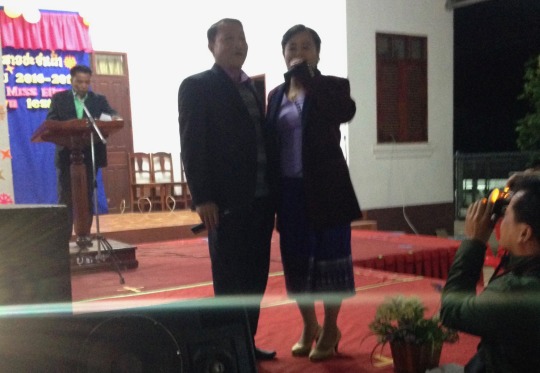
I was made aware of another ex-pat conundrum in Siem Reap, Cambodia when I checked out a yoga studio in the town’s tourist hub. Paul was the South African owner of Ahimsa Yoga. And while the Sanskrit word ahimsa translates as non-harm, his demeanor was anything but harmless. When I inquired about the class style, schedule, etc. I was barraged with an uninvited litany of complaints about the LA hard-body divas who come to his classes thinking they have nothing to learn, the phony instructors who have commercialized yoga world-wide, and the foolishness of the scantically-clad co-eds that prance through his studio as well as the Siem Reap streets and then complain when local Buddhist men (not accustomed to seeing a women’s knee or shoulder in public) harass them. I took that as my cue not to return for the sunset flow class and chalked it up to another angry escapee, seeking refuge from the discontent of home only to swap it for frustrations of another ilk.
We did, however, meet several far more exemplary models of ex-pats doing genuine good abroad. The Aussie manager of Luang Prabang’s Saffron Café, another perfectly first-world styled coffee shop, partners with a local owner. They use only Laotian beans, roasters and staff and contribute 100% of business profits to Laos communities of need. And Joanna was the British owner of Ok Pok Tok, a divine respite perched over the Mekong, where we stayed for two nights. The four romantic villas are surrounded by lush gardens and adorned with top-quality textiles crafted by the tribal women they employ from around the country at the weavers coop which is located on the same grounds. Sandra and her Laotian business partner travel widely to discover and support indigenous artisans. From some they purchase wares in their remote communities and take on all the risk to sell them to tourists in the city. And for another 30 villagers, they offer a home and a job on their beautiful premises.
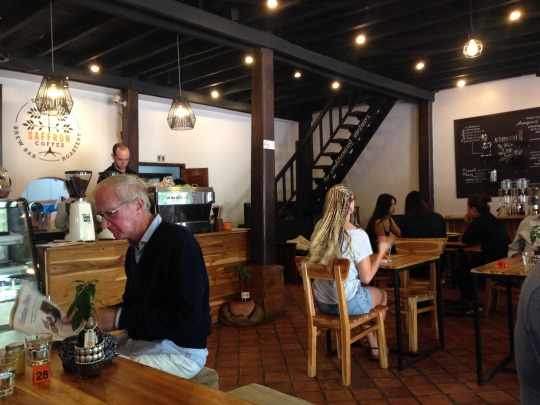
Inspirations
January 11, 2017 – Of Southeast Asian NGO’s, from Kuala Lumpur
Foreigners were hardly the only philanthropic folks we met either. Local social enterprises abound in Laos and Cambodia. Friends International is an awesome organization that provides drop-in centres, transition homes, and education to marginalized youth. It also trains street kids from both countries in gourmet cooking and then employs them in one of their 8 restaurants (in LP, Siem Reap, Phnom Penh and more). We ate at Luang Prabang’s branch, Kaiphen (named after the aforementioned riverweed snack). And it was hands-down our best meal in South East Asia. Laotian-style fish tacos with mango salsa, smoked eggplant puree on homemade baguettes, as well as prawn corn fritters offered us a delectable twist on local cuisine. And I scored a funky wallet, repurposed from Cambodian magazines, at their gift shop too.
Another notable project, and one quite relevant to my work, is Phare, the Cambodian circus troupe we saw perform in Siem Reap. Their pole climbing, silks flying, fire juggling acrobatics were astounding. But even more impressive was the Art for Social Change aspect that similarly trained street youth in circus arts intent on creating professional opportunities for them. The act included high-quality live music, dance, acting and storytelling as well, because their school provides a fully interdisciplinary training. And the end product, whose narrative had a powerful social message about bullying, could easily rival Cirque de Soleil standards too.

But the most fascinating NGO I discovered is run by Fi, who sat next to me on my flight from Siem Reap to Kuala Lumpur. His company’s innovative app, AgriBuddy, is serving thousands of rural farmers to digitally track their GPS location, size, crop inventory, fertilizer needs, etc., so that they can legitimize these small businesses and act as intermediaries to arrange bank loans for growth and sustenance. All very inspiring as I embark on my next social venture abroad.
Nature of Memory
January 12, 2017 – Of Southeast Asia, from Kuala Lumpur
I find so fascinating the fleeting nature of our memory stores. Images, senses and experiences which I have not called up in years come flooding back with the simplest triggers when I travel. Particularly with unfamiliar or infrequently encountered sensations, my brain scrambles to make associations, perhaps to ground my mind and body into my new surroundings. The Bugs Café in Siem Reap immediately conjured up reminiscence of the ground ant coated fish we ate in Oaxaca or the larvae Geoff accidentally ingested in Thailand, when he mistook the honeycomb he was served for actual honey. The blinged-out Cambodian tuk-tuks, no-pun intended, took me right back to Northern India where we guiltily let a geriatric man bike us up an outrageous hill. (Luckily, they are motorized in Siem Reap.) The sweeping frenzy that is pervasive throughout Asia, to keep the constant dust at bay, reminded me of the great pride Cubans took to keep their small patches of land or front stoops immaculate. And certain landscapes instantly harken an inventory of similar features I’ve seen before. As if my brain keeps all waterfalls stored in the same folder, Laos’ cascades brought me back to Bolivia, Switzerland, and of course the Sea to Sky highway in my backyard. The harrowingly steep karsts of HaLong Bay bore a striking resemblance to Norway’s fjords and New Zealand’s Milford Sound. The songs of Cambodia’s monkeys and frogs reminded me of my favorite critters’ croaks and howls in Bali, so much so that just hearing them made me imagine a distant gamelan. And while I’d heard each of the individual auditory elements from Siem Reap’s Pub St. before, its syncopated soundscape of motorbikes, limbless beggars, men hand-churning ice cream, and house music blaring from its street bars was a melange unlike any other. Then, the crowds thousands deep, jockeying at the Angkor Wat night market for a myriad of plastic silliness, fried food or colorful local crafts, took me back to every other Asian market I’ve ever braved. Finally, joining the armies of mostly tourists who flocked to the summit of Siem Reap’s Phnom Bhagan or Luang Prabang’s Pu Si mountain, for the most advantage view of the “best sunset in the world”, felt exactly like the lemmings we followed to do the same in Santorini, Greece or Cinque Terre.

Of course, I know that I may not be doing justice to the uniqueness of each of these places by comparing them so closely. Perhaps, also, this need for recognition defies my ability to fully appreciate their nuanced differences. However, I cannot deny my synapses’ tendency towards such filing. And, admittedly, the fact that land formations and human behaviors tend towards common patterns across the globe actually both touches and comforts me. I am, after all, the daughter of a Jew and a Catholic raised to look more for parallels than conflicts amongst ideologies. So, I won’t resist doing the same when I step in mangy Indian street doggy doo and think that it smells like Yukon husky poop.
Visiting Giants
January 12, 2017 – Of Siem Reap, from Kuala Lumpur
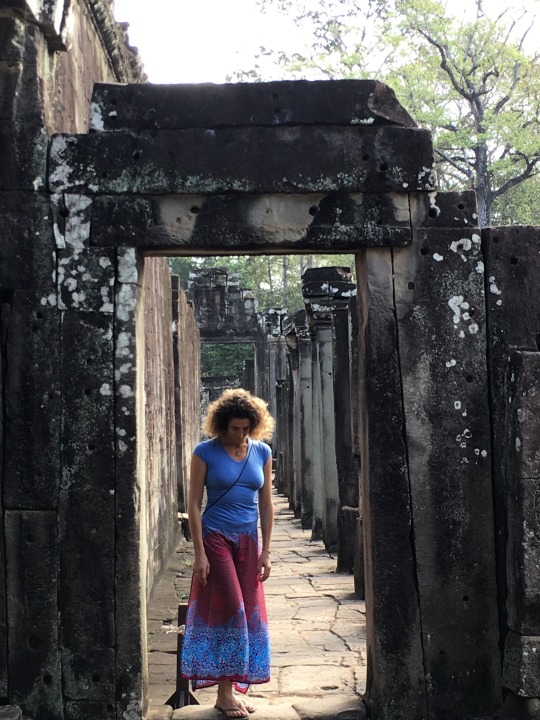
As is often said, travel is about the journey rather than the destination. But some end points are, in fact, the point. And a handful actually do live up to and beyond all the hype. Angkor Wat certainly tops this list. Before we travel to various places, Geoff and I both resist seeing too many photos, particularly of hugely popular sites. And though we could not avoid having seen a handful of images from these temples throughout our lifetime, the extent of their beauty and magnitude remained a secret until we were there for ourselves. It is difficult to put into words the mystique of witnessing her majesty revealed as the sun rose over her five-crowned glory. That we shared this moment with 10’s of thousands of other tourists, mostly Chinese clicking their Canons at a shot a second, took nothing away from this experience I’d wished to have for my entire adult life.

Extra surprising were the uniquely beautiful aesthetic qualities of several other temples in the region. My absolute favorites were the four-Buddha faced pillars that serenely smiled against spotless skies at Angkor Thom.

And as I wound my way around the creepy roots that have strangled but still preserved the stones of Ta Prohm, I felt I was in my own Indiana Jones adventure and am only grateful that they have not let more Hollywood producers co-opt this setting, to let it maintain its mystery for most.
A numbers buff, I also adored the endless layers of wings and corridors at Preah Khan, whose hall of mirrors-like effect gave me the sensation of being embedded in an architectural fractal.

So, for those who shun the roads most travelled, all I can say is that this world wonder is certainly worth shedding a hang-up or two.

New Realities
January 12, 2017 – Of Cambodia, from Kuala Lumpur
We are all now bound to each others’ realities in so many ways. Internet, films, and other rapidly spread media images mean that many children in African can recognize Spiderman, and a good number of North American adults can identify a burka, a burrito, or a banyan tree by sight. To me, the Buddhist Tree of Life, pictured below, represents the many intertwined branches that comprise humanity.

These global ties help build empathy and break down “us and them” barriers. However, they also leave increasingly fewer mysteries and surprises. This is why I relish, all the more, those rare new discoveries that travel still sometimes affords, even if the lessons are harsh. The ubiquitous landmine music bands, in Cambodia, were a shocking introduction to the vestiges of the civil war under the Khmer Rouge – thousands of limbless, deformed, blind and deaf performers lovelessly sawed at violins, hammered on dulcimers, and pounded on drums in what appeared to be an empty government gesture to create some kind of paltry vocation for their injured citizens (funded only by the donations from tourists). More cheerful was the realization that Cambodians celebrate their marriages in grand but casual style – up to 50 guests (in everything from jeans to gowns) gather in sprawling outdoor covered patios, over mounds of food and drink, with music blaring from giant subwoofers. One of our drivers taught us that each guest is asked to give an ample minimum contribution, (generally equivalent to $40 USD or more) to cover the festivities cost and to set up the happy couple with several thousand dollars for their new life together.
Solo Travel
January 12, 2017 – Of Cambodia, from Kuala Lumpur

I’ve now been in Asia without Geoff for 4 days, and I’ve been surprised to find myself somewhat disoriented as I’ve proceeded with my trip alone. I’ve done plenty of solo travel before, but rarely have I been “abandoned” part way through a journey. So, even as fiercely independent as I consider myself, I cannot deny that I experienced an unsettling feeling of being untethered when Geoff first left. Of course, as a couple whose greatest compatibility lies perhaps in the way we approach travel, we get into a comfortably flowing rhythm on the road that, as my Grandpa Barron always used to say, “makes beautiful music together.” Therefore, it has taken me a few days to get “in tune” with my new song. To do so, I gravitated to the familiar. My first night I dropped into a hippie bar, where I shared pillowed papasan chairs with chatty foreigners, as we exchanged travel tales over margaritas. Geoff and I crave connection with strangers when we travel, but invariably opportunities infinitely expand when you’re on your own. The crew at the Asana Bar included a divorced American mom who’d taken her two teenage girls out of the US as fast and far as she could, so disgusted by the latest political turn there. She’s got hardly a penny to her name, yet they plan to stay in Cambodia indefinitely, each finding ways to make ends meet (café jobs for the kids, a coop grocery gig for mom, homeschooling and more to learn from the School of Life than any American public school could ever provide.) The coop owners were there too – a gay couple – one guy from Africa and the other from the UK, well settled into a Siem Reap groove. I also really bonded with a French woman who has traveled the globe and worked remotely, for years, as a filmmaker and editor involving local amateurs in her work wherever she goes, and educating them in her art form.

My second attempt to find my own wings, of course, involved a bicycle. I rented a one speed for the day, for 2 bucks, and headed 12 k south of town to check out Tonle Sap Lake – apparently the most fish-rich lake in the world, and a point of pride mentioned by every Cambodian we met. Western ways are the norm in Siem Reap (short shorts and halter tops, beer drinking, and pop music). But I should have known that exposed shoulders and knees (even in 35 degrees Celsius) would get me too much unwanted male attention the moment I was inches from the city boundaries. Nonetheless, this venture let me see working waterwheels, rural villages, rice paddies, my first Southeast Asian mosque and more. My first day on two wheels instead of four served as a healthy refresher course in the mindfulness that solo travel brings. And as I felt my uneasiness begin to settle, I slowly became moored to my surroundings – no longer untethered.
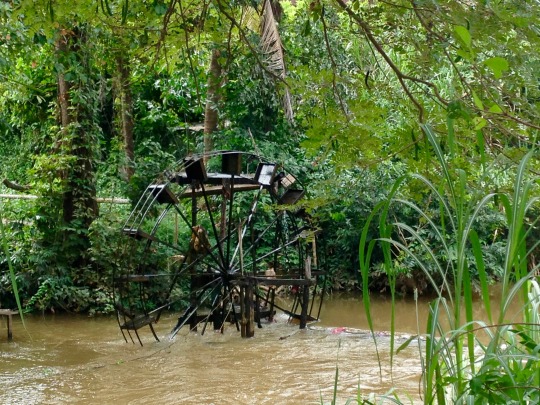
Austerity and Indulgences
January 13, 2017 - Of Transitions, from Kuala Lumpur
That I’m booked to leave for India on a full moon and Friday the 13th certainly adds to my trepidation about the unknowns that await me. But now, as I take my 6th flight in half as many weeks, I marvel at the ease with which most travel plans flow. That I can be walking in freezing rain in Canada one moment, and swimming under tropical sun only hours later never ceases to amaze me. And almost nothing fills me with greater glee than seeing a smiling gentleman in a Cambodian airport with a huge MISS LAURA sign in his hands simply because I sent my hotel an email ride request. I still consider it a minor miracle every time a travel plan actually comes to fruition. And though I’m usually an optimist, I’ve lost enough luggage, missed enough flights, and arrived to enough overbooked hotels to almost expect major mishaps every time I set off on another adventure. But the truth is, almost things actually do work out. And my 90+% successful track record is what gives me the chutzpah to take some leaps even though they still terrify me in certain ways.
Geoff and I like to leave lots of room for spontaneity. So, most of our rooms or internal fights are never pre-booked. But the greatest risks we’ve taken have been during our bike tours in Cuba and Laos, where there was no guesthouse info available en route. And most accommodations were about 50-100 kilometres apart. This was the case when we left Luang Prabang on rented mountain bikes, loaded with only 2 outfits each and a few repair tools for the week ahead. 65 k into our ride, as dusk approached, we had not seen a guesthouse for hours and we could tell form GPS that the next “town” was at least 10 k further. This had me as thrilled as I was scared, while I peeked in the few barebones bungalows that we passed along the road trying to imagine how I might humble myself to ask a local villager if we could sleep on their floor for the night. I’ve met several far braver travelers than I who’d almost exclusively survived this way, and I was always inspired by their courage. So, It hardly seemed a bad last resort. But it was also no guarantee. However, just as dark set in, we came across the sparse Pak Nga guesthouse where we managed a comfy bed and a hot shower in a windowless room for just $3. And again, I percolated with wonder at our fortune.
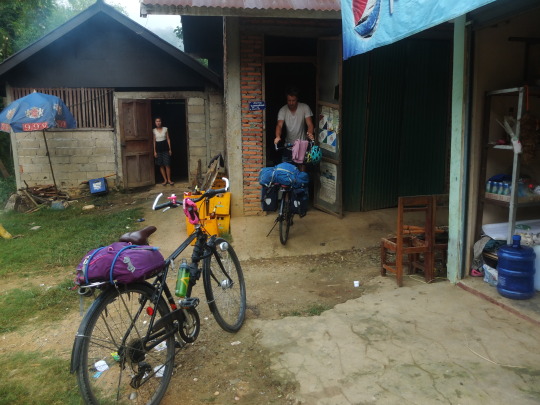
I’ve also always prided myself on such bargains. And I sort of wear, as a badge of honor, my ability to endure the meagerist of housing amenities on the road. But on the cusp of my 2nd half century of life, with a lower tolerance for undesirable odors, a bum neck that whines without a proper pillow, and ahubby hubby with an excellent paying job and a penchant for good design, I’ve surrendered some of my low maintenance ways. And I must admit that I’ve savored the subsequent perks along the way. In Laos, we scored three different spacious riverfront bungalows with private balconies, daily fresh fruit and bottled water in the room, fragrant toiletries and safes for our valuables. The comfort and security usually still only cost us less than $50 a night, so I could barely resist.
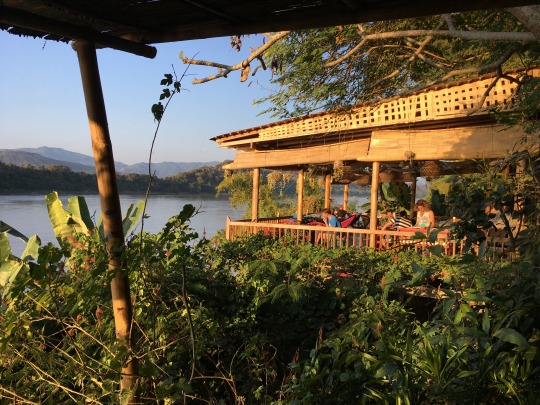
I even got so accustomed to our new standards that I agreed to splurge, for our last 4 nights in Siem Reap, on an $80 room at the incredible Mulberry Hotel, the luxuriousness of which you could probably not book in North America for less than $500. At any rate, accounting was the last thing on my mind as we finished every sweat and dust filled morning temple visit hilling at Mulberry’s glorious pool, surrounded by Buddhas, frangipani, and geckos while we ate complimentary spicy peanuts washed down with tamarind mojitos. The good life is not so bad after all.

All that said, I have only 1 more night of spoiling, at my flutist friend Shashank’s home in Chennai. When Geoff and I stayed there in 2007, we were treated like royalty with 3 multi-course gourmet veggie meals a days, a four poster bed, and a driver. But after their place, it’s back to basics for me, where I’ll share a room with other Child Haven volunteers, sleep on a cot, take cold bucket showers and eat dal for most meals along with the children who live at the home. And, of course, that is all just as it should be, and I plan to relish such immersive living. But of course, I hope my tangled curls, my belly and my cervical spine have not become too “soft” to handle it!
on their floor for the night. I’ve met a few far braver travelers than I who’d almost exclusively survived this way, and I was always inspired by their courage. So, It hardly seemed a bad last resort. But it was also no guarantee. However, just as dark set in, we came across the sparse Pak Nga guesthouse where we managed a comfy bed and a hot shower in a windowless room for just $3. And again, I percolated with wonder at our fortune.
Loss
January 15, 2017 - Of Sparks and Wings, from India
This was far from the entry I imagined I would write today. I have arrived at Child Haven International, in Kaliyampoondi. The distorted sound system of a Tamil film blares across the dirt field of the Home, no longer filled with young cricket players because they are all riveted to the screen inside their dining hall. This special form of entertainment is their treat for the occasion of today’s holiday, Pongal, Tamil Nadu’s harvest festival. Rangoli designs adorn the concrete foundations of the campus buildings, each chalked in multi-colors to create the beautiful mandala-like designs that honor this festival. And yet I struggle to feel festive today, despite the hugs and kisses and hand holding that every child and staff member greeted me with upon my arrival. Because they should be showering Maggie too. But instead, in a tragic turn of events, she is on a plane headed home after receiving the shocking news that her father suddenly died of respiratory failure on a jungle trek in Peru. We were apart when she heard, awaiting our rides to the Home from separate friends’ places in India. She learned over Facebook – something no daughter should ever have to experience. I learned on a video chat with her, while long pauses and glassy eyes showed how little either of us were able to truly process this.

Morton Winston was an exceptional man, and while we are often inclined to say that of people once they pass – with him it is entirely true. For years, he served as the President of the Board of Amnesty International. Maggie was raised in a family that, at times, harbored Burmese refugees; at others, spent years abroad helping the unjustly served in Nepal, Thailand, South Africa. Though little can be of solace in the wake of such a loss, I have to hope that her father’s adventurous soul would have wanted to come to rest in a place as wild and wonderous as the Amazon. Inspired by her father’s example, intrepid travel and community service have been second nature to Maggie. Morton also married into a remarkable family of women, each power house arts activists in their own right. Together, they have collected Canada Council honors, film and dance awards, and accolades too numerous to mention. Maggie always jokes about holiday family dinners, where simple “what’s new?” catch-up conversations rival Nobel Peace Prize presentations. And in keeping with this generosity of spirit, amidst her moment of crisis, Maggie still managed to secure a fellow theatre artist, living nearby in India, who could take her place as my collaborating facilitator for these two weeks. She said she found it a helpful distraction while she could do little for 2 days as she waited for her changed flight to depart. I am deeply grateful to her for this gesture. I will meet Kaeridwyn for the first time tomorrow, where she lives in the intentional community of Auroville (below) – perhaps one of the most sustainable and successful of its kind in the world. Since the 70’s, this non-denominational autonomous society has grown to a thriving community of 5,000 from over 50 countries. I relish the chance to learn about her alternative living, and to learn from her artistic expertise in physical theatre and some of her own forms of puppetry.

How ironic though that, only two entries ago, I marveled that most things actually do go to plan. Yet, of course, I’m now harshly reminded that this is only true except in those 1 % of times when they absolutely do not. As I sit alone in the Home’s library, digesting this sad and sudden change of plans, wondering if I can still be of true value here, I pass the day reflecting and reading, as I will do until our project begins on Tuesday. And here, I quickly came upon several texts, left by former volunteers, which my intuition somehow knew I needed to discover.
· A Tagore verse: “The butterfly counts not months but moments and has time enough.”
· Gary Zukav’s Soul Stories that claims “the journey of a hawk depends on both the hawk and the wind. Sometimes the wind takes the hawk where it wants to go, and sometimes it doesn’t. When it doesn’t, the hawk doesn’t mind. Either way, hawks are masters at flying, always in control of their own wing and tail feathers. This is what elegant spirts do.”
· And the charming biography of Child Haven’s founder, Bonnie Cappuccino, written by her “long-suffering” husband Fred. They opened their first of nine homes and schools (serving almost 2,000 youth in India, Nepal, Bangladesh and Tibet), 30 years ago, at the ripe young ages of 53 & 60, after raising their own 21 children into adulthood (19 of which they adopted). For their astounding efforts they have received the Order of Canada and a UNESCO Human Rights Award. Their inspiring book’s final words read: “Glowing deep within each one of you is a divine spark. Some of you may be skeptical, or feel you are unworthy, yet the divine spark glows. This divine spark may surprise you as the future unfolds. It may lead you to risk much in some wild act of compassion. You are of infinite worth; you possess a dazzling beauty that is irresistible. Trust this divine spark glowing in your deepest being.”

Thank goodness Bonnie trusted hers. And thank goodness the wind seems to have been on her side when she’s needed it. Not when they found a brain tumor that paralyzed the right side of her face. Not when one of her treasured children committed suicide. But certainly when her second cancer surgery succeeded. And several times, when she has managed to overcome seemingly insurmountable obstacles, immigration nightmares, civil wars, natural disasters and more to create and sustain Child Haven’s nine thriving homes. Bonnie was on the Air India plane that left Montreal in 1985, crashing and killing 190 people. Only she took its incoming flight to YYZ, before those fated passengers boarded on their way to London. The wind was with her that day. It is hard to understand what the wind intended for those 190 others. None of us can ever answer such questions. I guess we can only keep flying and continue to be the master of our own wings.
Wayfinding
January 19, 2017 Of Kuala Lumpur, from Pondicherry, India
After Cambodia, Air Asia’s wings took me to Malaysia for an extended layover before my India project began. My whirlwind arrival reminded me that finding my way in a new surrounding is one of my favorite travel pastimes. I landed at the Kuala Lumpur airport solo, soared through immigration, collected my luggage, scored local currency from the airport ATM, located the train terminal, successfully navigated the ticket machine, boarded the correct train, managed a station transfer without a hitch, and then walked straight to my hotel front door, all in just one hour. My feat gave me a rush equivalent to winning the Amazing Race. But thanks to GPS and surprisingly clear wayfinding signs, this was actually quite doable and not really as impressive as it might seem.
For my first night, I stayed in the commercial district of Bukit Bintang, in the heart of the city just meters from the fabled Petronus towers. On first glance, downtown KL appears nothing but a conglomeration of neon, highways and malls. The latter rival the opulence of Fifth Ave, with marble floors, high speed escalators, and posh stores like Prada and Sephora, built in post-modern architectural style. But no amount of polish is able to hide the same litter, sewerage stench and stray dogs that one can find almost anywhere in Asia.

My Canadian friend and Malaysian resident, Lisa Sauer let me know that her new home is a nation rapidly striving to attain first world status, but too fast for its capacity. Thousands of luxury high-rise condos stand empty, built over-ambitiously and without proper amenities to service them. A government program to mass distribute Western toilets throughout the country has dramatically failed to meet its targets. And an ever-increasing disparity of wealth keeps many still living in squalor while others enjoy every continental comfort. Craft beer, high speed wifi, pools and tennis courts in most middle to upper class apartment buildings, quinoa and kale smoothies at Whole Foods-like grocery stores, and even flat whites at Aussie-inspired cafes are the norm in the mostly ex-pat neighborhood of Mont Kiara, where Lisa generously hosted me for my final three nights.
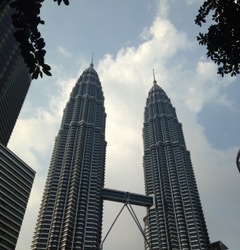



Such economic imbalances trouble me, just as they do at home. But I can’t deny that a few more days of indulgence did provide a welcomed breather for me as I prepared for the intensity and austerity of India. And I can certainly understand the appeal for many to stay in this city, surrounded by the familiar while still only a $100 flight from an endless stream of exotic destinations. Lisa and her partner Jeff are able to spend long weekends in Bali, have Christmas holidays in New Zealand, and take quick jaunts to Hong Kong with the ease of a trip from Vancouver to Seattle. It was a privilege to witness the full life that they’ve carved out for themselves there. It was also a treat to discuss books, share concerns and criticisms of “the orange man who will remain nameless”, and to swap travel highlights and travails. Lisa is the most intrepid person I know. She can only keep track of the countries she has NOT visited, because this list falls only in the single digits, while the count for those hundred plus principalities that she has experienced keeps changing with history’s shifting geographical borders. Though a rhythm-loving musician and chronic counter myself, I have resisted the urge to innumerate my own travel destinations, for years, realizing that a qualified life is always more well-lived than a quantified one. However, I learned in Morton Winston’s obituary that he always aimed to visit more countries than his current age. And that someone as substantive as he set himself this challenge gave me permission to do so as well. So after my own tally, I realized that Lisa’s new home marked 46 for me, leaving me close to my new 50 by 50 goal, with only 16 months to go. If all goes to plan by then, I’ll make it to Brazil for another school project, to Nicaragua for some Spanish practice, to Australia to teach some university Art for Social change workshops, and finally to Burma, where I will sail with several of my best buds to mark my passage into the second half century of my life. But I’m also open to wherever the wind might take me…
Imprints
February 8, 2017 Of India, from Vancouver

One week after my return to Vancouver, I stare at the red faded swirls on my left palm, willing the mendhi design to last just a bit longer, in much the same way I strive to keep the lessons of my trip alive. I can still practically count the hours since 15-year old Sangitha, one of our most keen Indian students, artfully applied the henna to my limbs on my last night. Yet, I can already feel the glow of my skin, the bloom in my heart, the sparkle in my eyes starting to dim despite my best efforts. I remember when I attended the Dalia Lama’s 10-day Kalichakra teachings, in Dharamsala in 2007, and I finally understood why people go to church. Between five daily hours of exposure to his wise words, 10,000 global visitors engaged in high-minded discourse at every café, hostel and momo shop, inspired to live better, be better. I got caught up in this too. But with every passing day after leaving his Himalayan refuge, my behavior slipped ever so subtly, and I wished I could be in the presence of his radiance yet again. I needed the nudge that I now realize church provides for the most earnest seekers, whatever their faith.

Like then, for two weeks in Kaliyampoondi, I easily relinquished coffee, alcohol, cursing, and even ill thoughts of others while I was immersed in my purposeful existence there. But it took only two days home for a Canadian friend’s “us and them”ing of Americans, (the very same dangerous thinking that led “the despot who won’t be named” to implement his dreaded immigration ban), to set me off into a temperamental rage, the negative effects of which lingered for several hours. Gone seemed the equanimity and compassion that so grounded me when I faced numerous cultural differences in India and throughout my trip. Only a day later, a string of unnecessary expletives escaped my mouth after a simple computer glitch, as I mourned for the analog-nature of my intimate face-to-face Indian exchange. And finally, a third Saturday night cocktail, sipped only out of habit not need, had Geoff and I walking home from a dinner party on separate sides of the street over a trivial thing I’ve already forgotten.
Art is my temple. And the privilege to witness its transformative power, despite language barriers and gaping cultural differences, is what nourishes my soul. There is also something undeniably sacred about India. Beneath the cow dung, beyond the open sewer stench, besides the archaic gender dynamics that still perpetuate inexcusable oppression and violence towards women, there is a palpable grace. Just to watch the sincerity in the Child Haven kids’ closed eyes and furrowed brows as they chant their simple pre-meal prayer is to truly know this. I was reduced to tears, daily, by similar profound expressions of spirituality. Indians also bring exquisite beauty and ceremony to every occasion, as seen in the stunning saris that Child Haven students wore for their Republic Day school dance performance.
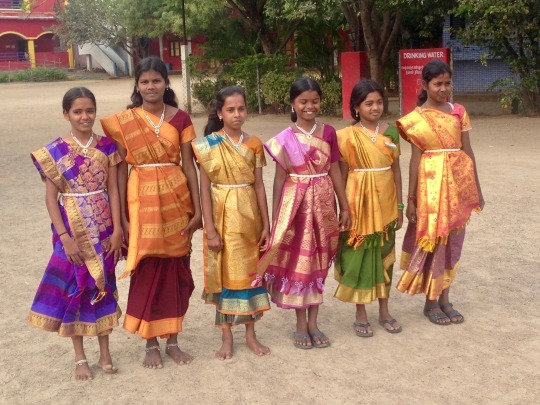
In only my two brief weeks there, I experienced 5 state holidays and 4 additional rituals for special occasions at the Home. Pongol is South India’s harvest festival. And I was treated to its chromatic splendor the instant I landed. I arrived in Chennai just prior to midnight, terrified that there would be some grave error in my visa-upon-arrival form, and that I’d have no way to get cash for a cab. I’d heard that India’s prime minister had taken 5 & 10 thousand rupee notes out of circulation to prevent black market counterfeit. Consequently, this had left the country with a currency crisis and practically no working ATM’s as they scrambled to print more small denominations. However, to my surprise, I waltzed through immigration in a record 5 minutes (faster than YVR), and successfully exchanged my last $100 USD for 4,000 rupee (a crap rate since the Global Bank quoted 6,000, but I was happy to take anything at that point). Then, I braved the sea of pre-paid taxi stands to secure the best deal, proceeded to be accosted by a team of drivers jockeying for the right to my fare, and chose the most geriatric of the bunch figuring he was my safest option. I gave him the address of my friend Shashank’s posh neighborhood which he pretended to recognize. But of course, he proceeded to stop a half dozen times for directions. Luckily though, Pongol had most families still up at that hour, diligently chalk-painting their stoops with amazingly symmetric Rangoli mandalas. This vibrant display of communal art-making let me know I had, indeed, arrived in India. And she instantly got under my skin.

Detours
February 8, 2017 Of India, from Vancouver
Geoff and I stayed with Shashank exactly ten years earlier, mid-way through our year-long trip around the world. We’ll never forget our lively discussions with his family, about art, politics and travel. And we can still taste the epic 6-course meals that his mother and wife prepared for breakfast, lunch and dinner every day, as they did on this visit too. That Shashank is also a world-renowned Karnatic flutist only added to the richness of our visit, as we were treated to daily rehearsals in his living room. And this time, his ten-year old daughter Swara (aptly named after a musical note, and still in Siri’s belly last we came), was the one displaying her own virtuosity on the blues guitar.
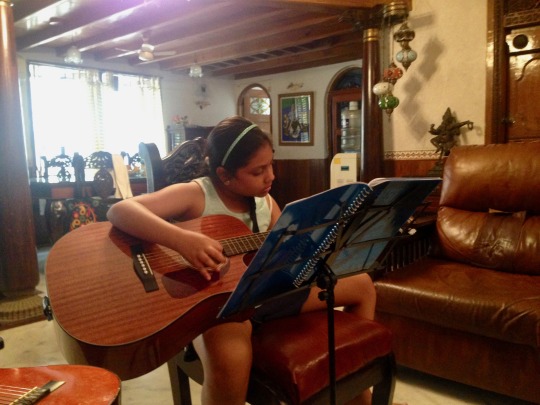
But sadly, it is the Skype call that I had with my dear Flagstaff colleague, Michael Sullivan, on that first morning in India, January 15th, 2007, which I most remember. With shock and horror in his eyes, Michael revealed to me that he had just learned he had a terminal bone cancer, the ravages of which took him before we even returned home in June. So, a mere glance at Shashank’s desktop computer made me long for my friend. How odd, then, that it was on that very same screen I read Maggie’s message about her father’s death, again on my first morning at his home, this time on January 14th, 2017.
And so the detours began. Maggie’s to Baltimore, and mine to Pondicherry and Auroville, to meet my new artist partner, Kaeridwyn, where we’d revise a plan that would best align with our complementary skill sets. Of course, our sessions had been scheduled to begin on Monday, but as has seemed to become the norm on these global projects, the Child Haven director neglected to mention that Pongol celebrations continued through Tuesday evening. To lose 20% of our scheduled 10-day engagements would have normally set me into a panic. But instead, I seized the opportunity to pivot, explore another Indian destination, and bond with my new colleague. That I also fit in long walks on Pondicherry’s seaside boardwalk, marveled at parades of sari-clad women in their holiday finest, visited their Ghandi statue, and enjoyed one more night in a cush b&b was only a bonus. But I’ve come to appreciate that detours are always full of such perks.
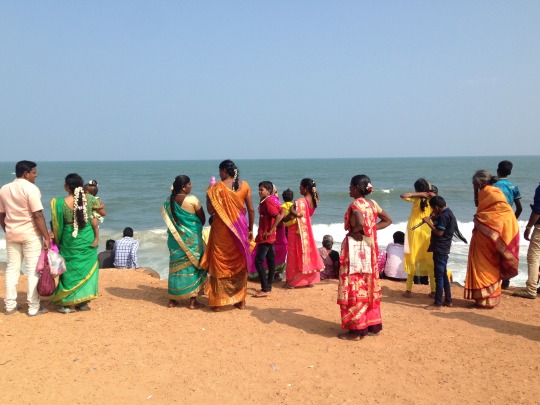
Silverware and Other Taboos
February 8, 2017 Of India, from Vancouver
Another of my favorite aspects of India is her cows, who roam her city streets, lighten her chai, and transport her people and goods. Cows were the talk of the town during my visit, as the state had just outlawed the ancient Pongol practice of jallikattu,which is South Indian’s version of “running with the bulls”. So, while blue Americans and their global peers hit the streets to protest the horrifically racist policies of the “man who shall not be named”, Tamil Nadu’s streets were alive with their own activists. But these were not the PETA version that one might expect (animal-lovers standing up to support the abolishment of a practice that is cruel and violent to the bull, and which kills several bold and foolish men each year). Contrarily, the prevailing sentiment of the protesting citizens (largely university students) favored the maintenance of this ritual, as these deeply traditional people feel their government too often threatens their ancestral connections. As I’m partial to protecting animal and human rights, I was, no doubt, very surprised to learn about the nuances of this controversy. But I realized I was ill-equipped to understand such a complex and age-old battle.
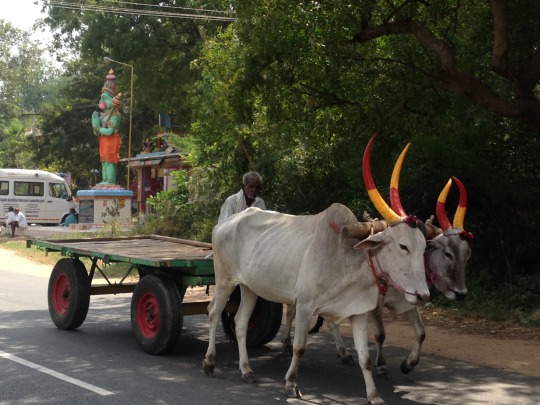
I was born in bovine country myself. And cow-tipping was a high school pastime for me and my friends. But our version involved only a harmless ringing of their bells, rather than a full body topple which I’d learned some rural US farm kids preferred. For most Hindus, cows are sacred, revered for their gentle nature and agricultural assets. Perhaps this, too, inspired me to become a vegetarian as well as an ice cream fanatic by a very young age. I virtually started my career in the industry, with jobs in five different parlors between the ages of 13-20. With such a shining for these adorable heffers, I also invariably took a preponderance of cow photos on my routine bicycle excursions to neighboring Uthiramerur. Most amusingly, Indians paint the horns of these honorific beasts for Pongol, the brilliance of which lasted throughout my fortnight. And while close sleeping proximity to animal feces is not usually something I would celebrate, I was actually comforted when a Child Haven staff first walked me to my room and I was greeted by the Home’s five dairy cows whose pen was just five feet from my door.

Eating meat was the easiest of India’s taboos for me to avoid. But their other eating practices took more getting used to. In keeping with the rock-hard mattress that I slept on, our meals were served on the floor of a giant chairless, concrete dining hall. So, three times per day, I joined all 250 children, 30 staff, and a half dozen other volunteers as we ate cross-legged and with only our hands to ingest the splendor they served us each day. The puffy rice flour dumplings, called idly, which the cooks miraculously prepared by the thousands to perfection, were the easiest to eat without cutlery. But rice with spicy mango stew, chickpea curry, or ginger chili pesto posed tougher challenges. And I found that tearing chapati (their rice flour pancakes) one-handed was the trickiest feat of all. But, of course, this was essential because their lack of toilet paper meant that all self-cleaning was done with the left hand, leaving only the right free for dining. However, whatever discomfort these new habits caused became quickly overshadowed by the children’s infectious joy and gratitude during meals.
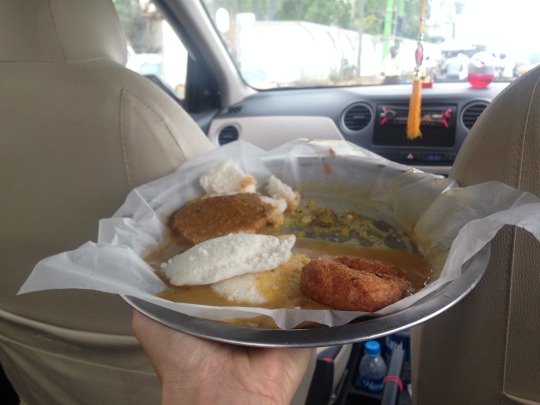
Adapting to their dress code, though, did not come as rapidly. Kaliyampoondi is located deep in traditional Southern India where gender roles are clearly delineated. The public domain is largely male, and the home female. Throughout rural Tamil Nadu, girls and boys sit on opposite sides of their school classrooms, as they did in the dining room at the home. This persists despite Child Haven’s strongly imparted Gandhian beliefs of gender equality which result in their generously funding every single child’s university tuition (male and female). However, in keeping with such contradictory divisions, we were only allowed to work with each gender in separate sessions throughout our project, and this led to a variety of interesting observations. While boys wore short-sleeved button down shirts and tailored pants to school, and then changed into Western shorts and t-shirts for afternoon play, girls (by the age of only 10) had to wear chudigar in most contexts. This oppressive uniform included large, knee-length, polyester shirts with baggy pants and an additional shawl (or dupita), carefully pinned to their shoulders to cover even the smallest bloom of a bosom. Additionally, these heavy layers are worn throughout the year, which peaks to 120 Farenheit in the summer months! And girls had to wear similarly unrevealing clothing around the home, even as they ran 800 metre dashes in preparation for their State-wide Sports Day competition, which was scheduled for my departure day. Here they are with my new buddy and volunteer, Andy Rush, as they arrive home on the new bikes that every Grade 11 child was gifted under a special government program.

This dress code was also enforced with female volunteers at the home. And though I am eager to honor foreign traditions when I’m abroad, it was difficult to abide, while I watched male staff and volunteers wear jeans or whatever else they liked. Some even enjoyed topless morning runs. However, what I found most disturbing was the community policing that the girls did with each other, as well as with the volunteers, to adjust a slight slip of the shawl or accidental exposed bra strap. Of course, I was keen to avoid being corrected or perceived as disrespectful in any way, so I soon found myself routinely fussing with my own scarf. And I quickly came to imagine the body shame and self-consciousness that these strictures could breed. Consequently, it became highly evident that the boys exhibited far greater self-esteem and exuberance, as well as a willingness to improvise and be playful. That said, I was amazed how much the girls’ confidence grew throughout our project. So, I soon forfeited my inclination to fight such bewildering practices, and recognized that my time would be better spent focusing on scalable transformative change through our arts engagements rather than on massive systemic change.
Superheroes
February 9, 2017 Of India, from Vancouver

Inspired by the ideals of Mahatma Gandhi, Child Haven International was founded in 1985, by Bonnie and Fred Cappuccino, the superhero couple that I previously mentioned. Their non-profit has built nine healthy, sustainable homes for almost 2,000 children and women in India, Nepal, Bangladesh, and Tibet. And each of these “havens” provides food, shelter, clothing, health care, educational and moral support for their residents. Most children go on to pursue post-secondary education, and Child Haven even funds their university tuition. The homes are fully run and staffed by locals, along with a handful of volunteers from abroad (largely Canadians). And Gandhi’s principles of gender equality, no caste (or class) recognition, non-violence and vegetarianism, simple living, as well as respect for all religions and cultures breed a positive, life-affirming energy that I felt during every moment I spent at their homes in both Kathmandu (for a 2015 arts project) and Kaliyampoondi. This fertile ground provided the ideal environment for our arts engagements. So, it is no wonder they resulted in, perhaps, the most impactful project for Instruments of Change, to date.

Amidst cicada and frog song, morning starts at Child Haven with the children’s 5 am wake-up bell which elicits an occasional bark from Puppy, the resident dog. As the children are meticulous about cleanliness, they proceed to pridefully brill cream and braid their hair, wash their bodies, and press their uniforms to perfection. These thorough ablutions are followed by meditation, non-denominational chanting, and a jog around the large grounds of the home. Then, they queue up for their daily protein, a sweet, warm cup of soy milk, made from soybeans that are crushed, right there on the property, by the machine they affectionately call the “soy cow”. They form similar lines to receive breakfast, lunch, snack and dinner, and this 300+ person dance proceeds with remarkable order.

In fact, observing these young people choreograph their shared space, day in and day out, was perhaps the most moving part of my experience there. In the spirit of simple living, each child’s entire worldly possessions (clothes, shoes, jewelry, toys, toiletries, photos) fit into one small metal suitcase. Consequently, there is little sense of “mine, mine, mine”, just like we witnessed in the Nepal home. Throughout our project, the children cooperatively shared supplies, decorations, and tools without incident. They were equally gracious about returning things promptly, in good condition and exactly where they found them. Our limited stock of erasers presented the only sharing challenge, as they took the same pristine approach with their work as they take with their appearance. Of course, we are always careful to dispel notions about “right or wrong”/”good or bad” art in our projects. But habits run deep. So, there was nothing left of our 10 inches of rubber erasers by the end of our two puppet-designing sketch sessions. However, their diligence certainly paid off, as seen by these fanciful characters that they created.
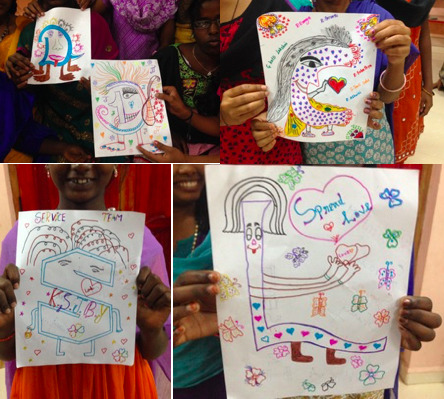
During our project, entitled Repurpose Our Purpose, we asked kids to express their feelings about their own unique value and purpose (or, in other words, their superpowers), through story and song. At the same time, they harnessed the value of everyday objects and trash by repurposing these materials to make puppets and instruments for a final original theatre piece. And finally, we introduced a variety of interdisciplinary collaborative activities designed to cultivate an appreciation for the power of a collective sum that is greater than its parts. The first of these exercises asked students to identify with certain Jungian archetypal personality types (IE. Jester, Creator, Explorer, Sage, Leader, Caregiver, Innocent, Hero, or Rebel). Then, we organized them according to their chosen type, and these became their working groups for the duration of the project. Subsequently, they performed physical gestures that represented their Archetype’s character, demonstrated by our Boy Jesters, with their thumbs to their noses.

They also collectively brainstormed a vocabulary of words related to the assets of their chosen superhero characters. And while we relied heavily on the excellent translation provided by 4 helpful staff members, Ganesh, William, Johnson, and Poppy, this activity revealed that the students had a stronger command of English than we had realized earlier in our project. Below are their own words, placed anatomically correctly, on the Body of a Superhero that they chalked on their playground.
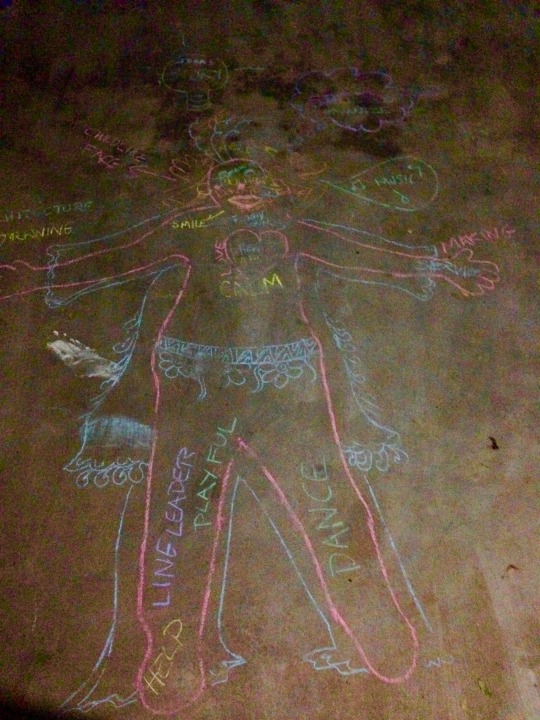
Ultimately, each archetype group chose the most resonant word to describe their character’s superhero, and the first letter of this word became the body shape for their puppet design (IE. M for Meditation as the Sage’s superpower, and D for Dance as the Creator’s superpower). Then, they brought these creatures to life using reclaimed cardboard, bicycle tires, scrap paper, styrofoam and newspaper waste. Predictably, their creations were full of saturated color and ingenuity, as is everything in India.
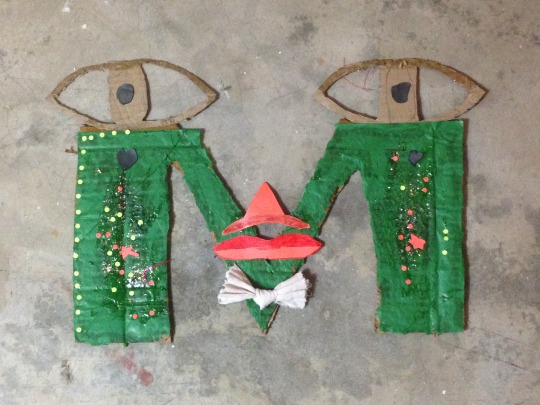

And the designs did not divide along typical gender lines, as the sweetness of this Caregiver Boys’ heart-balloon covered puppet illustrates. These resourceful children also took the upcycling aspect of our project to a whole new level as they proceeded to cut scrap gold metallic paper into hundreds of tiny bits to make their own glitter!

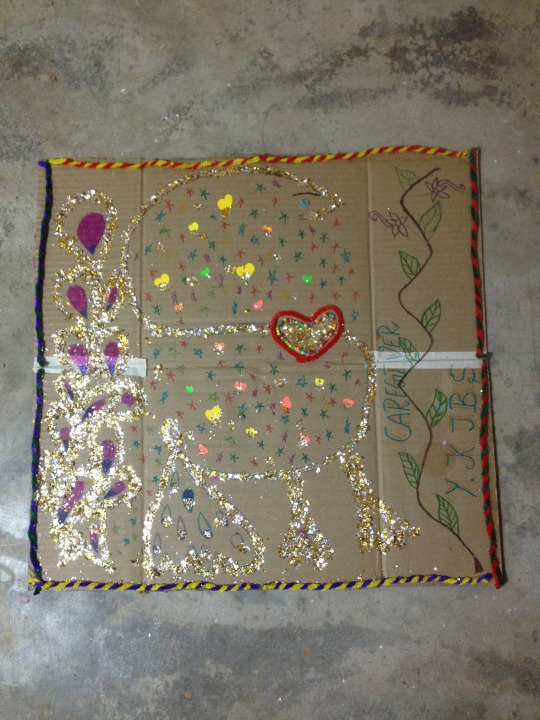
To further develop narratives for their characters, we presented the children with a scenario (much like a videogame simulation), where each puppet (1 per archetype group) had to collectively pass through a series of obstacles. However, we set the rule that each challenge could only be solved using one of the puppet’s superpowers, (referencing the idea that the whole is stronger than the sum of its parts). So, each archetype group invented both an appropriate problem and a solution with which their superhero could “save” the day for all their peers. The girls and boys created separate narratives, each with their own host of diverse characters. And some of their most memorable storylines were when the Boy Sage taught everyone to meditate so they could levitate over a cold, impenetrable river; and when the Girl Creator drank a magical chocolate soy power drink after all the puppets became immobilized by the scorching sun. Then, she led them all in a dance that revitalized their energy. These are both, interestingly, very Indian solutions. I was also thrilled to learn that the Boy Hero group chose Music as their super power. In their creative storyline, after the whole puppet group gets trapped in a house, set ablaze by fire, the singing hero puppet plays his guitar and the musical notes that emanate from it magically transform into water that puts out the flames. Additionally, to develop their dramatic skills, Kaeridwyn led the kids in found object animation activities. Below, they are enacting a “fart” scene (or “susu” in Tamil). It was, of course, heart-warming to see that adolescent poop jokes transcend cultural boundaries. And clearly, our young-at-heart translator, Johnson, thought so too.
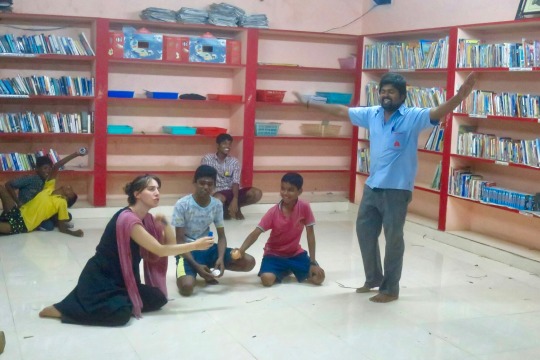
Here I am listening intently to the Boy Leader’s plan out their scene.

And this is Kaeridwyn directing the whole crew of boy puppeteers in their opening scene.
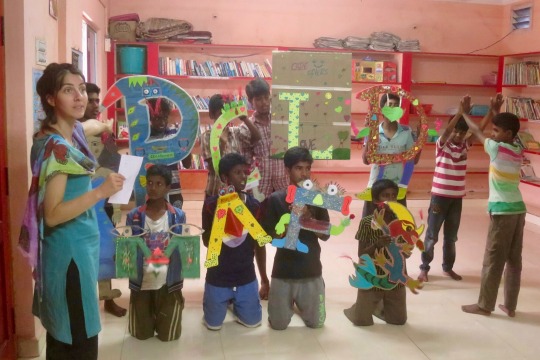
Over two weeks, we were allotted one hour per day with each gender group. However, the children were so invested in our project that they went over and above the call of duty, spending several additional hours writing their stories, practicing their actions, and fabricating their puppets. This is exactly the ownership we always strive to cultivate in our work.


We also put in our fair share of extra time, administering puppet triage and other vital work, graciously helped by Jackie, (in the back of the photo below). It was incredibly fortuitous that she and her husband, Andy (in the bike photo from Feb. 8th’s entry) happened to be volunteering during our visit, because they are, respectively, a retired music and English/drama teacher. They supported nearly all of our sessions with their expertise and cheery presence, and Kaeridwyn and I could not believe our good fortune to have their help.

For the music component of our piece, the kids brainstormed about qualities essential for good team work. Then, we analyzed the musicality of this language by breaking the words into rhythmic syllabic categories, according to spoken stresses (IE. Re-spect; Leading, Sharing, Kindness; Unity, Confidence, Discipline; Following; Concentration; Cooperation). These evolved into both chants and drum beats that they performed with their voices and found object instruments. To warm-up these budding percussionists, we used stray firewood for sticks and turned their playground into a drum kit. And for their instrument scavenging, which I’ve previously led in Vancouver alleys and Kathmandu streets, we had to go no further than the grounds of the home itself, for they had a plethora of sonorities right on the premises (10-gallon water jugs for drums, empty 10-litre bottles and beans for shakers, damaged tin plates and cups for cymbals, and giant 5-foot rice barrels for bass drums).
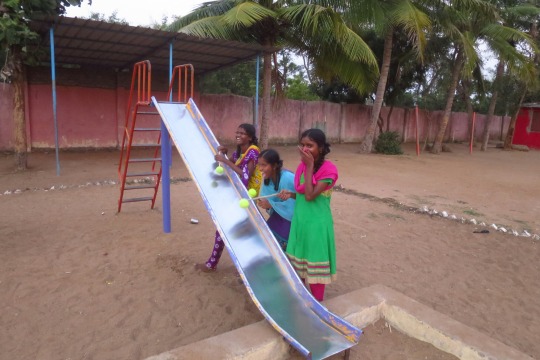


A most boisterous time was certainly had by all. And we’ve received reports that the children have continued to chant the lyrics around the home, since we left two weeks ago. Another legacy of our project has been the re-mount of their puppet show for Bonnie, when she visited just one week after our departure. Their sports director, William, had so skillfully translated for us, that he was able to hold up the fort by himself, rehearsing and directing their repeat performances. Jackie sent me this photo of all the kids’ animated faces while they sat through the entire hour-long show for the second time.

Excitingly, the children may even get a chance to “take it on the road” if Kaeridwyn succeeds in securing them a showcase at Auroville’s Upcycling Festival in mid-March. It is this kind of sustainability that we aspire to achieve in all of our work. But the nature of two-week arts engagements run the risk of merely serving as “hit and run” projects, particularly with communities who have little additional exposure to artistic activity, like in Kaliyampoondi where their schools’ rigorous academic expectations emphasize a STEM rather than a STEAM (Science, Technology, English, Arts, and Math) curriculum. In fact, on top of their 6-hour school day, Child Haven kids diligently study at least 3 more hours per day. We even witnessed those approaching state-wide exams (Grades 10 & 12), downing chai until the wee hours of the night to pack in a few extra hours of study. Academics aside, there was at least one artistic discipline with which the kids had lots of experience - dance. That’s because they are treated to a Tollywood (Tamil Nadu’s version of Bollywood) film every Saturday night, and they’ve memorized the moves from all of their favorite scenes. So, we knew we had to end each of their puppet shows with a dance number.

What we never could have counted on, though, was the spontaneous eruption of all 250 kids in the audience, when they began to dance along, after the boys’ last piece. The enthusiastic Director of Child Haven, Ganesh, consistently voiced how impressed he was by the efficacy of this type of arts-infused learning. In fact, he was the one who made the final call to keep the Tollywood music blaring after the show, lending itself to what we learned was the first ever time that Child Haven boys and girls danced together in one room, at the home. So, maybe systemic change is not impossible after all.
In addition to the meaningful encounters that I had throughout our engagements with the children who participated in our program, there are so many moments I keep returning to, now that I am home. Showers of hugs and nose kisses from kids young and old, never too-cool-for-school to demonstrate their appreciation, as many adolescents at home would be. Afternoons, sitting with the other volunteers, on the kitchen’s dirt floor, thumb wrestling, hair braiding, bean cutting, and playing paddy-cakes with the kids. And 7 am theatre games with the irresistibly adorable littlest ones who were too young to participate in our main project.




But what remains deep in my bones, after my time in Child Haven, is the profound sense that there are potent ties which bind us all on this fractured, complex planet. This is not to glibly say that we are all one, or that our similarities outweigh our differences. Certainly, there are gaping distinctions, for example, between the realities of the children that I work with in Canada versus those in Kaliyampoondi. However, I cannot escape my roots, which grounded me to see connection rather than division. I am the daughter of a Russian Jew and an Italian Catholic. And I was fortunate to be raised in a Unitarian church, where we were exposed to the wisdom of a multitude of global belief systems, and where social justice was preached instead of religious dogma. Understandably, this inclusive approach focused my lenses to look for common ground. Not surprisingly, a number of volunteers that have come through Child Haven over the years have also been Unitarian. And Fred Cappuccino even spent his career as a UU minister. The remarkable organization that he and Bonnie have built clearly responds to the basic human truth that we all need to be loved and feel safe. And I now believe, more than ever, that the role of the artist activist is to respond to a different basic human truth - that we all want to be heard. That we all want to express what moves us, and we want to do so beautifully. That no matter how different our life experiences, we want to find those deepest knowing parts of ourselves that can empathize and relate to our fellow humans and then, put them into words, or dances, or pictures, or songs. In other words, we want to connect to our inner spark, give it wings and let it take flight.

2 notes
·
View notes
Text
Dr. Jada Benn Torres - Triniricua
“Use the tools that other people have taught you, and make them work for you. Create these narratives that seem a little more reasonable,
given what you know about people in your community.”
Dr. Jada Benn Torres is the most revolutionary genetic anthropologist of our era. Her work intersects the operationalization of race, anti-racist methodology, and indigenous Afro-Caribbean cultural exchanges. Of Trinidadian descent, Jada and her Boricua husband raise their Triniricua family in Nashville, Tennessee. Progressing from the first and only molecular anthropologist at the University of Notre Dame to the department of anthropology Associate Professor at Vanderbilt University, she is leading multiple projects that will bless future generations with knowledge of ancestral lineage and antiracist genetic research. Jada is a kindred spirit who deserves ample support, exposure, and resources for the awakening she is unraveling.
“Genetic Anthropology is interested in anything that has to do with making us human and how we have adapted, culturally and physiologically, to our environment. And understanding the genetic basis of that. I look at ancestry and study how various social practices/strictures have shaped genetic variation.”
Acknowledging the eurocentrically western medicinal methods of racial identification to deduce diseases that are prone to some “races” and not others, Jada challenges the lens at which western medicine enforces the operationalization of race. As an example, women of African descent develop uterine fibroids more than women of other backgrounds. Albeit used over-excessively, race is an unbiological factor that does not affect their susceptibility to fibroids. However, mitochondrial DNA within women of African descent tells a story of matrilineal lineages from regions of the African continent. DNA samples Jada and her husband retrieved during their four month honeymoon traversing the Caribbean have produced an impeccable revealing: undoubted Afro-Caribbean cultural and genetic exchanges that have directly affected the modern-day Afro-Caribbean population.
DNA is a material is encoded with instructions for who we are and what we pass on to our offspring. Genetic Ancestry uses DNA to look at various lineages. Mitochondria has its own DNA, which is separate from the DNA within the nucleus of each cell. While one inherits DNA in the nucleus from X and Y chromosomes, mitochondrial holds DNA only from the X chromosome. Mitochondrial DNA holds our maternal lineage. Portions of mitochondrial DNA are organized into genetic families known as haplo groups, made of individual haplo types. Each haplo type is as different as two siblings within one family unit. Haplo groups are continent and region specific, some genetic families more common in Africa and others in Asia. The same is done with the Y chromosome, which carries the paternal lineage.
Y chromosomes and mitochondrial DNA are unilinear markers, tracing one line of ancestry. Torres’ argument is, “for groups of people that have been systematically denied any knowledge of their history and past and where they came from: it is a lot. It is a lot to know I can trace my lineage back to an ancestor that traveled across a huge migration in Africa, something that shaped the way the continent is today. From a population scale, it is really informative to use unilinear markers because they tell you where people were going. In the
Caribbean, you see specific patterns of inheritance from African descent. There is also, within the Caribbean, maternal ancestry from the Americas. Indigenous American women contributed to these communities as well. However, you don’t see European women contributing to these communities. Thats says something about the strictures that made it dangerous for European women to be in non-white communities. On the flip side looking at the Y chromosome, you can find paternal ancestry connected to indigenous American men. Because the unilinear markers for indigenous American men are so few, we know that a lot of paternal lineages were lost. There weren’t many indigenous American men left to contribute to modern Caribbean society. So if you’re gonna colonize someone, you go after the people that you think will fight back and that was the men. I don’t think they’re lost, I think we’re not looking in the right place.”
In addition to ushering medicine closer to ethical uterine fibroid prevention and treatment for women of African descent Jada works toward the intersections of genetic anthropology, politics, and art. Collaborating with artists to relay their individual responses regarding Afro-Caribbean genetic data, Jada is cross-pollinating her scientific activism with non-scientists. Refuting eurocolonial claims of population history in the Caribbean, Jada is filtering “official history” to unveil true stories. The impact of her work transcends obstacles of racial inferiority complexes. Knowing where we come from is of the utmost importance to our success as children serving our Mother Earth. If we know where we are from, we will know where to go and who to be. If not, we are vulnerable to eurocentric and heteronormative misinterpretations of our identities, as well as having no sense of home nor belonging. Knowing where we are from ensures we feel inherent connection to land. Dismantling the colonial notion of “ownership”, Jada invites us to theorize the ways genetic markers (mutations in DNA) influenced migration, cultural exchanges, and biology. Biologically, her research highlights the development of diseases and immunity in the Afro-Caribbean population (of ancestors and descendants).
Co-authored with her husband Gabriel A. Torres Colón, in Racial Experience as an Alternative Operationalization of Racethey “propose an operationalization of race that is attentive to both racial experience and human biological diversity—placing [the two] within the same ontological sphere. Furthermore, [they] argue that this approach can more effectively advance antiracist pedagogy and politics.” Her intersections span from genetic anthropology to genetic epidemiology, which is the study of disease distribution. “Gene hunters look for the genetic basis to disease. I have interest here. Moreso, how environment and cultures shape patterns of disease. With a specific focus in women's health and why so many women of African descent have fibroids I am doing research now on that at Vanderbilt, understanding how women have dealt with this. I’m getting under the genetic underpinnings that have merged biology and culture. Why are fibroids more common in African American women? I am cross culturally looking at different ways people deal with it. The current cure is basically a hysterectomy. All the organs and the uterus are removed. That is the cure. For a lot of people there is a greater meaning to that organ. It makes them women. Taking that away doesn’t just cure fibroids. You are taking a major part of their being away. Many women stay with fibroids and deal with the consequences to avoid losing what to them is their womanhood.”
Torres is also working in collaboration with Afro-Puerto Rican artists on the island to commission art of the artist’s interpretation to their genetic ancestry data. Torres is
revolutionary because her work values, grounds, and supports ancestral legacy. Her projects validate genetic variations and exchanges. All that makes us us, made our ancestors them. She is a bridge. Her bridge is the shape of a sextile, merging disciplines across varying fields that study the human being and body.
“The idea that race is biological is wrong. For the most part, most mainstream anthropologists don’t subscribe to those ideas anymore. Idk if we have the best terminology yet to talk about human variation. We know it exists. You can look at me and you. There are differences between us. How can we talk about those differences? How can we talk about what those actually mean?
Working with Afro-Puerto Ricans who established that 60% of [Boricua] women have matrilineal lineage from Tainos. Some Afro-Puerto Rican communities felt they weren’t adequately sampled. Given my passion for African ancestry in Caribbean, I sought out these communities. I am looking at the way the transatlantic slave trade dispersed families. Genetics can potentially change then. I’m working with these Afro-Puerto Rican communities to ask musicians, sculptures, performance artists and et cetera to interpret their genetic results. There are beautifully connections made in how we understand and interpret our identities. I mean I can sit here and show you pie charts and allele frequencies and get all excited cause that’s what I like. It’s really cool to explain something to someone and see how they perceive it through their eyes and their medium. As a science that is interested in learning about human experience, there is a lot of overlap with artists and their artistic ways of interpreting the world.”
0 notes
Text
Hyperallergic: A Family of Artists Creates a Portrait of Inuk Life Across Three Generations
Installation view of Akunnittinni: A Kinngait Family Portrait
Three generations of artists from Kinngait, the renowned center of Inuit printmaking best known as Cape Dorset, are on view in an exhibition that consists of a century-spanning matrilineal exchange of forms, stories, and values. Akunnittinni: A Kinngait Family Portrait is titled for the Inuktitut word akunnittinni, meaning “between us,” and features work by Inuk grandmother, mother, and daughter Pitseolak Ashoona, Napachie Pootoogook, and Annie Pootoogook. Their prints and drawings resonate with intergenerational themes of motherhood and community, and the exhibition is itself a sampling of the history of the resilience of Inuit life in the face of the complexities of modernity and globalization as seen through the lens of a single, extraordinary family of artists.
Work from Kinngait is not infrequently shown in New York. Most recently, in late 2016, the Brooklyn Museum presented programs with the Cape Dorset Legacy Project to supplement its collection of Kinngait work from the 1950s to the present. It is also a major moment for Inuit artists internationally. Kananginak Pootoogook, a family member and one of the first Kinngait printmakers, is now the first Inuit artist to be shown at the Venice Biennale, having been selected for this year’s Arsenale exhibit seven years after his death. Closer to home, the exhibition SakKijâjuk, organized by Heather Igloliorte — the first major show of Labrador Inuit art — is now currently touring across Canada.
Pitseolak Ashoona, “Dream Of Motherhood” (1969) stonecut, 33 3/4 x 24” (courtesy Dorset Fine Arts)
However Inuit art’s popularity has never taken off in the United States in the way it has in Canada. In part, this is due to the history of Inuit print making’s ties to efforts by the Canadian federal government to promote Inuit arts as a means of economic sustenance for northern communities and the resultant craze for the highly collectible work that emerged in the rest of the country. In 1957, James Houston, a representative of the Canadian Handicrafts Guild, later hired by the Department of Northern Affairs, introduced techniques of printing to Kinngait with stone-cuts and stencils, and in 1959 he brought printing and workshop techniques from Japan to guide and organize the work of the newly incorporated West Baffin Eskimo Co-Operative. Under these Japanese methods, original drawings by artists were chosen by separate block-cutters and printers who completed the printing process, and for the first two decades of its operations a team of nine men did the majority of the block cutting and printing at Kinngait. The co-op model encouraged profit sharing and consensus decision making, and the egalitarian setting allowed Inuit values to operate with support from business savvy of advisors like Houston who capitalized on the market’s desire for what it saw as authentic representations of Inuit culture.
At the same time, this model accommodated southern Canadian desires and ambivalent feelings towards the Inuit, while modernizing Inuit labor and maintaining their traditional values and distinct culture as highly collectible works of art. While the first critics of Inuit art debated what precisely was “authentic” in Inuit art, southern audiences eagerly consumed work that often omitted elements of the contemporary in favor of timeless images of arctic life.
Annie Pootoogook, “A Portrait of Pitseolak” (2003–04) colored pencil and ink on paper (courtesy Edward J. Guarino Collection)
The promotion of Inuit art was thus an attempt to encourage assimilation to a capitalist, colonial economic system and the formation of permanent settlements for indigenous peoples who had otherwise been self-sustaining while seasonally transient. Following its great popularity, Inuit art has since become a national symbol for Canada, as evidenced by the work of famed Kinngait artist Kenojuak Ashevak recently being added to the $10 bill. At the same time, it has flourished over the last sixty years as a site for individual Inuk agency and cultural expression that is resilient to and representative of the pressures that modernity has exerted on life in the North.
Akunnittinni, though, moves past the belabored topics of market making and the in/authentic modernity of Cape Dorset printmaking to pursue matrilineal discourses internal to the community. The effect is an inward-looking familial history, rather than one, as described above, that focuses on the needs and desires of southerners.
Pitseolak Ashoona, “Woman Hiding From Spirit” (1968) stonecut, 27 1/4 x 24 1/4” (courtesy Dorset Fine Arts)
Pitseolak Ashoona’s drawings and designs were a feature of the beginnings of Kinngait print making, and her subject matter reflects the concerns of that early period. Born in 1904, she grew up with a family life of subsistence living, and, following the death of her husband, moved to Kinngait with several of her seventeen children to seek out an income. Her prints tend to omit signs of contemporary life and the south, as most early Kinngait work did, thus appealing to audiences seeking images of a timeless and pristine Arctic life. Ashoona often lingers on the spiritual as well as the stories and ways of life of previous generations. In “Woman Hiding from Spirit” (1968) the negative form of a female figure lays in front of a bear-like spirit that does not seem to see her. Sprouting from the spirit’s head are antlers and birds who fight over berries; the woman is nearly face to face with one such bird — speaking to the closeness of the human and spiritual worlds in the North. While none of Ashoona’s best known works are on display, prints like “Dreams of Motherhood” (1969) put the theme of the exhibition into the long line of generational knowledge that reaches back to precolonial life. Sitting on the main woman’s head is the image of a mother holding an ulu knife and carrying an infant in her hood — an image of transgenerational motherhood that is of a value beyond Euro-American consumption.
Napachie Pootoogook, “Trading Women for Supplies, (1997–98) ink on paper (courtesy Edward J. Guarino Collection)
The tensions among such seemingly timeless subject matter, modern materials, and the production and marketing model of Dorset Fine Arts (the marketing division of the West Baffin Eskimo Cooperative) vexed anthropologists seeking to define from an outsider’s perspective “authentic” Inuit culture. But as Napachie Pootoogook’s work shows, Kinngait prints have never shied away from chronicling the flux of life in the North. Her work on display shows some of the darker aspects of a history that certainly do not fit the idealized image of an innocent, unrecoverable Arctic life. In “Trading Women for Supplies” (1997-98) and “Whaler’s Exchange” (1989), women are given to Euro-American sailors in mercantile transactions of sexual exploitation exchanged for supplies. Cannibalism is the subject of “Eating His Mother’s Remains” (1999-2000), a practice that, while not part of Inuit culture except in case of extreme famine, has been projected onto many indigenous cultures throughout history. “Alcohol” (1994), depicting a group of figures reeling, with several bottles strewn about them, demonstrates Pootoogook’s foray into particularly contemporary issues that were not necessarily present in Ashoona’s work.
Napachie Pootoogook, “Alcohol” (1994) colored pencil and ink on paper (courtesy Edward J. Guarino Collection)
It is the work of Annie Pootoogook that most strikingly demonstrates the ways traditional Inuit family life has been integrated into the modern North. This is the first substantial exhibition of Pootoogook’s work in New York since her widely mourned death in 2016 — a tragic reminder of the continued effects of the colonial legacy on indigenous women. Her drawings alone are reason enough to see the exhibition. A Sobey award winner in 2006 whose work was shown the following year in documenta 12 and in a 2009 solo exhibition at the National Museum of the American Indian, New York, Pootoogook’s work brings her family’s legacy into the immediate present by exquisitely picturing the intimacies of family life in a North inundated with southern goods and media.
The bands of color in “Couple Sleeping” (2003-04) demonstrate how sensitively, with her colored pencils, she treats the same paper used for Kinngait prints, creating an alluring surface that recalls the starry texture of Ashoona’s early prints. It is the epitome of an Inuktitut word sometimes substituted for art, sanattiaqsimajut: “these things that are finely made.” “Watching the Simpsons on TV” (2003) is an intimate and lusciously detailed domestic interior scene of family life that fills the page with details of a contemporary Inuit experience. It is a stylistic break from the isolated Inuit figure as seen in the work of her mother and grandmother, yet she also draws on that heritage. “Pitseolak’s Glasses” (2006) depicts her grandmother’s eyeglasses in a near-abstract manner that is reminiscent of engraved ivory forms. And a portrait of Ashoona herself on an isolated white background, not wearing a point-hooded parka, but a patterned dress and headscarf, ties the three generations of the exhibition neatly together — akunnittinni.
Annie Pootoogook, “Watching the Simpsons on TV,” (2003) pencil, ink, pencil crayon, 20″ x 26″ (courtesy Edward J. Guarino collection)
The selection of Annie’s work avoids some of the darker themes that she, like her mother, had taken up to critique the ongoing legacy of colonialism in the North. But the repeated emphasis on family and generational conversation rooted in matrilineal love and care can do the same work. The thematic connections across the generations of this family — motherhood, Inuit life in the face of modernity, and resilience — tell their own history of the Inuit response to an increasingly globalist present. Counter to the ambivalence that defined the southern reception of modern Inuit printmaking, Akunnittinni presents a model of intergenerational relations rooted in the Kinngait community that stands in the face of an increasingly globalist and precarious present.
Akunnittinni: A Kinngait Family Portrait continues at the National Museum of the American Indian, New York (the Alexander Hamilton U.S. Custom House
One Bowling Green, the Financial District) through January 8, 2018.
The post A Family of Artists Creates a Portrait of Inuk Life Across Three Generations appeared first on Hyperallergic.
from Hyperallergic http://ift.tt/2jnzYd0
via IFTTT
0 notes